April 6th, 2013
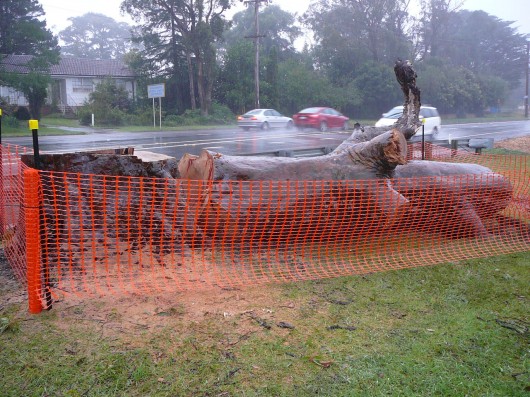 The trunk of a healthy 300+ year old Angophora lies beside the highway in Bullaburra
Blue Mountains, New South Wales, Australia
[Photo by our investigator, 20130403, Photo © ^Creative Commons] The trunk of a healthy 300+ year old Angophora lies beside the highway in Bullaburra
Blue Mountains, New South Wales, Australia
[Photo by our investigator, 20130403, Photo © ^Creative Commons]
.
Government destruction of Bullaburra has begun. Last Monday, April Fools Day 2013, they came and killed Bullaburra’s magificent Angophora to make way for a trucking expressway through the village. But who are the fools who destroy our native heritage?
To many perhaps this is just another tree. Some people value trees and ecology. Others have deep value for wildlife and other animals, especially their pets. Many people value where they live and grow very attached to where they live for reasons that can seem difficult for others to appreciate. But it is the existence rights of species that humans ignore besides their own self-serving interests. Male Baby Boomers remain the most extreme in their self-righteousness, and those in government prescribe utilitarian dictates over the rights of the few.
Elie Wiesel, novelist, political activist, and Humanities Professor at Boston University, has said that the opposite of love is not hate, it’s indifference. The opposite of beauty is not ugliness, it’s indifference. The opposite of faith is not heresy, it’s indifference. And the opposite of life is not death, but indifference between life and death.
.
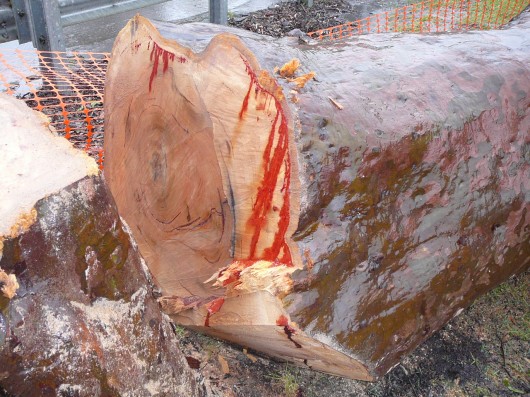 Witnessing an old friend being slaughtered
[Photo by our investigator, 20130403, Photo © ^Creative Commons] Witnessing an old friend being slaughtered
[Photo by our investigator, 20130403, Photo © ^Creative Commons]
.
A native tree that once was part of an Angophora (Sydney Redgum) forest, existed way back when the three explorers Lawson, Wenthworth and Blaxland crossed the Blue Mountains in 1813. They would have passed right past this tree. Two years later road builder William Cox similarly would have laid his rough track, and in 1836 Major Mitchell upgrading the road too would have passed by this tree. For nearly two centuries travellers have passed by this tree, most probably not even giving it a glance. Now it is gone and the opportunity to respect and appreciate this remnant of natural heritage has gone with it.
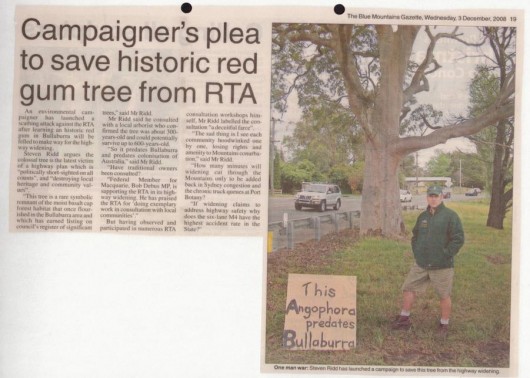 We tried to save you
Campaign to Save Bullaburra’s 300 year old Angophora back in 2008
(Blue Mountains Gazette, 20081203) We tried to save you
Campaign to Save Bullaburra’s 300 year old Angophora back in 2008
(Blue Mountains Gazette, 20081203)
.
Last January, spiteful people set fire to two Hermmansburg ghost gums made famous in Albert Namatjira’s landscape paintings. In 2006, Barcaldine’s famous ghost gum, ‘the tree of knowledge’ was poisoned. Just last week an old gum tree in the Rylstone public school was poisoned. Human hate for native trees has pervaded Australian colonising society since Cook landed at Camp Cove and chopped down trees for firewood.
.
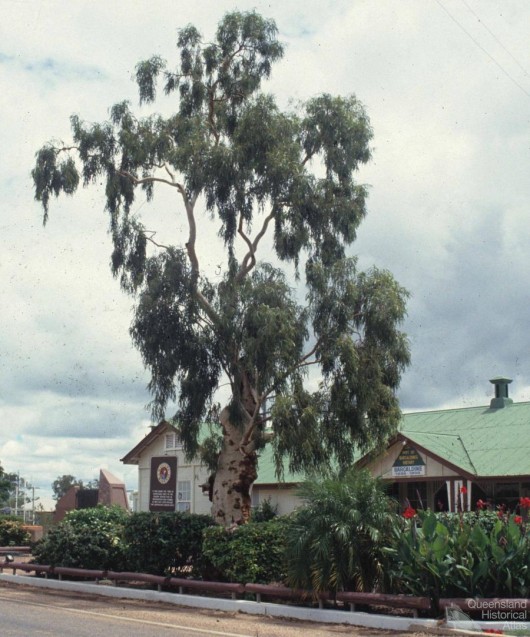 Tree of Knowledge, Barcaldine, Queensland
As it used to be, before it was poisioned.
[Source: Queensland Historical Atlas, 1991,
^http://www.qhatlas.com.au/photograph/tree-knowledge-barcaldine-1991] Tree of Knowledge, Barcaldine, Queensland
As it used to be, before it was poisioned.
[Source: Queensland Historical Atlas, 1991,
^http://www.qhatlas.com.au/photograph/tree-knowledge-barcaldine-1991]
.
A local arborist with expertise in native trees of the Blue Mountains including Angophoras, estimated in 2007 that the Bullaburra Angophora to have been over 300 years old. It was still healthy and still growing as confirmed by the solid core of the severed trunk.
Now it lies like a dead harpooned whale like roadkill beside the highway, where it has stood all those decades.
.
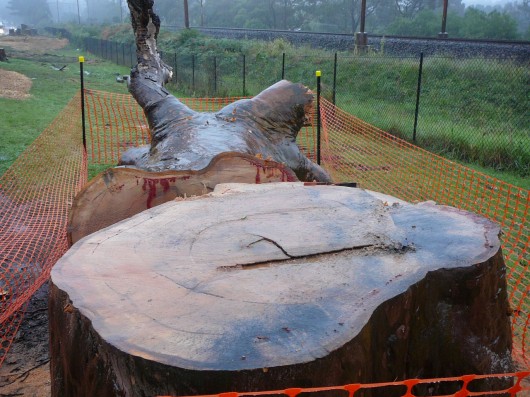 A dendrochronology of more than 300 annual growth rings.
The tree was healthy to the core. It was not rotting. It was not diseased.
It was just in the way of someone’s trucking interpretation of ‘progress’.
[Photo by our investigator, 20130403, Photo © ^Creative Commons] A dendrochronology of more than 300 annual growth rings.
The tree was healthy to the core. It was not rotting. It was not diseased.
It was just in the way of someone’s trucking interpretation of ‘progress’.
[Photo by our investigator, 20130403, Photo © ^Creative Commons]
.
Significant Tree #29
.
This Angophora was recognised as a ‘Significant Tree‘ on the local Blue Mountains Council’s Significant Tree Register back on 17th July 1985 and formally adopted on 21st June 1988, at the time of Australia’s Bicentennary.
No opposition against killing the tree was communicated by the Blue Mountains Council to the RTA-come-RMS. Indeed, this is one of many such ‘significant trees’ that have been killed for development convenience in recent years. Clearly, the Blue Mountains Council’s Significant Tree Register has become disingenuous and lying greenwash.
.
.
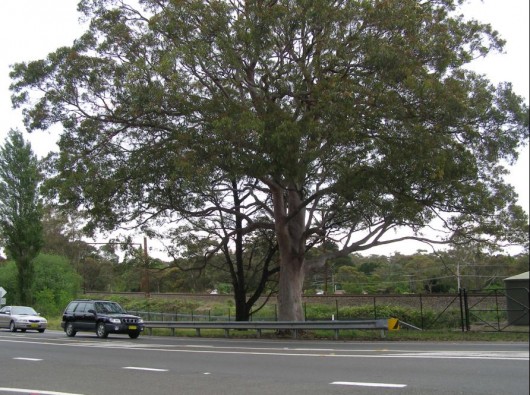 Bullaburra’s Angophora, in memoriam Bullaburra’s Angophora, in memoriam
Registered Significant Tree #: 29
Botanical Name: Angophora costata (Smooth Barked Apple, Red Gum)
Location: Great Western Highway Bullaburra, Opp. Lot 173, DP13407
[Photo by Editor, 20071028, Photo © ^Creative Commons]
.
Trucking Expressway
.
The death of the Angophora is the begining of the end of Bullaburra. The highway village is set to become a siding for four-laned trucking expressway so that B-double trucks can rumble 24/7 through Blue Mountains towns and villages, nudging 90kph on cruise control.
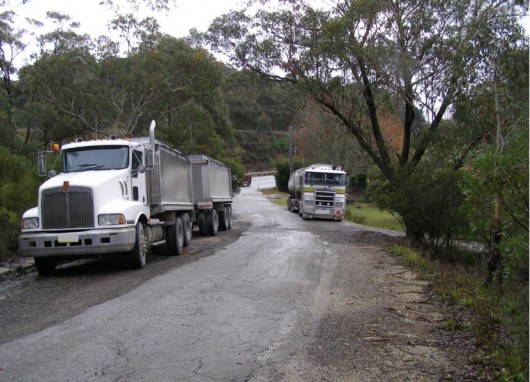 Bigger Trucks demanding bigger roads
[Photo by Editor, 20090531, Photo © ^Creative Commons] Bigger Trucks demanding bigger roads
[Photo by Editor, 20090531, Photo © ^Creative Commons]
.
The rural amenity of this highway village is to be lobotomised into a mono-design urban landscape taking on the same monotonous blandness as any other expressway in the country. The government euphemises this as:
.
“to achieve greater consistency in the design of the Blue Mountains area to achieve a simple and unified design of the highway and its elements.”
.
The fundamental basis for the government’s conversion of this regional highway into a national trucking expressway route is simply “to improve travel times” for trucks, so that more and larger trucks are encouraged to use the route.
The Bullaburrra section is to cost taxpayers $80 million and will see 3.6 hectares of native bushland destroyed on the basis that the vegetation “is already dissected and fragmented“. So it seems that moral relativism allows for wedge development just like a little bit of corruption doesn’t hurt anyone.
But as if the twisted morality isn’t bad enough. It is the greenwashing that really twists the knife in. The RTA-come-RMS in its Review of Environmental Effects maintains that the expressway development aims:
“to protect the natural systems and ecology of the corridor”
..
[Source: ‘The Great Western Highway Upgrade – Bullaburra East, Review of Environmental Effects’, Vol.2, July 2009, Roads and Traffic Authority, New South Wales Government, p.2.]
.
However, the expressway development will simply result in the heart of rural Bullaburra being ripped out and the amenity reduced to a trucking siding adopting a benale concrete landscape akin to the bland urban character of an upper Blaxland, and mirroring what has happened to nearby lobotomised Lawson.
.
“It’s just really tragic after all the horrors of the last 1,000 years we can’t leave behind something as primitive as government sponsored execution.”
~ Wisconsin Senator Russ Feingold, when introducing a bill that would end the death penalty on the Federal level.
.
Progress of Hate
.
Under Australia’s Federal Auslink Policy the national freight thinking is road-centric and all about replacing real trains with road trains. Behind this trucking expressway scheme is a powerful and influential trucking lobby group who donate generously to the political parties that control the New South Wales Government, and various politicians including retired Blue Mountains MP Bob Debus, who has long been a driver of this trucking expressway.
The New South Wales Government department behind this scheme is the RTA-come-RMS (Roads and Maritime Services). In 2007, the then General Manager – Environmental Branch, Ms Erica Adamson, claimed that to retain the Angophora consequential loss of tree roots and pruning would instigate the decline of the tree. “For road construction and safety reasons the tree will have to be removed…to maintain sight lines (for speeding trucks).”
“It’s called progress” they say. For the Blue Mountains it is being inflicted at any cost – economic, social, environmental.
The idea of ‘progress‘ is an economic one that was borne out of Western 18th Century hard-nosed Industrial Revolution and perhaps extending back to the 16th Century Enlightenment of Europe and perhaps even back to when the Iron Age triumphed so aggressively and effectively over the Bronze Age.
Perhaps progress remains subjective only with the progressor who doggedly in his pursuit rough shods over others in the process. Perhaps the idea of progress is a myth. Is the human condition better off as a result? Are we advancing as a society by rough shodding over others and over what is left of Ecology and Nature? The philosophy of ‘^Deep Ecology‘ posits otherwise.
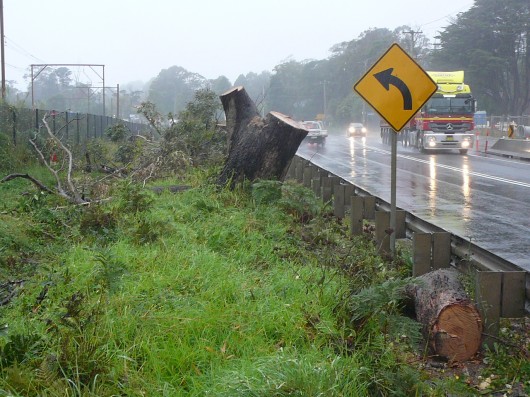 Progress of Hate
[Photo by our investigator, 20130403, Photo © ^Creative Commons] Progress of Hate
[Photo by our investigator, 20130403, Photo © ^Creative Commons]
.
“Progress means getting nearer to the place you want to be. And if you have taken a wrong turning, then to go forward does not get you any nearer. If you are on the wrong road, progress means doing an about-turn and walking back to the right road; and in that case the man who turns back soonest is the most progressive man.”
~ C.S. Lewis, Mere Christianity
.
Related reading on this website:
.
[1] >Threats from Road Making – articles
.
[2] >Bushphobia – a case of deluded convenience
.
Tags: Blue Mountains, Blue Mountains Council, BMCC, Bullaburra, Bullaburra Angophora, Bullaburra's Angophora, ghost gums, Great Western Highway, greenwash, RMS, Roads and Maritime Services, RTA, RTA-come-RMS, Significant Tree, Significant Tree Register, Tree of Knowledge, trucking expressway
Posted in Blue Mountains (AU), Threats from Greenwashing, Threats from Road Making | 1 Comment »
Add this post to Del.icio.us - Digg
Leave a Reply
You must be logged in to post a comment.
March 31st, 2013
 A hundred year old native Eucalypt killed for housing development
Wellington Road Katoomba, Blue Mountains
[Photo by Editor, 20130307, click image to enlarge, Photo © ^Creative Commons] A hundred year old native Eucalypt killed for housing development
Wellington Road Katoomba, Blue Mountains
[Photo by Editor, 20130307, click image to enlarge, Photo © ^Creative Commons]
.
Month by month, year on year, the native vegetation of the Blue Mountains is steadily disappearing lot by lot, hectare by hectare, for private housing development profit.
A native bushland site along Wellington Road on the bush fringe of Katoomba has been recently sold off for private profit, then bulldozed and trees uprooted ready for housing construction. Like so many such sites, once the house is built, it soon goes on the market for sale and profit.
Typically, it is not owner-occupiers buying up the bush, but property developers for quick sale and profit. Cummulatively, much of fringe Blue Mountains bushland is being flogged for profit. Cheap bush blocks are bought, bushland habitat is destroyed and private profit is made at the expense of cheapened ecology.
And real estate agents are in on the private profit making bandwagon.
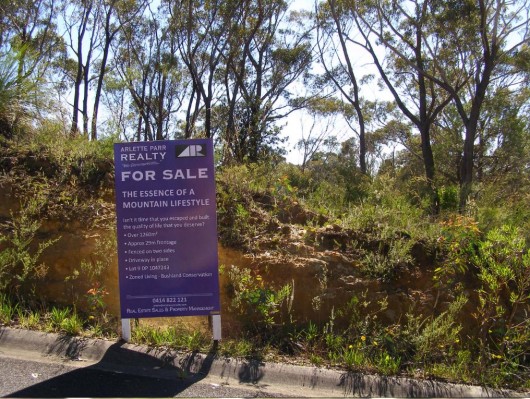 Katoomba fringe bushland flogged by real estate agents
Oxymoronic zoning: ‘Living – Bushland Conservation’
[Photo by Editor, 20130307, click image to enlarge, Photo © ^Creative Commons] Katoomba fringe bushland flogged by real estate agents
Oxymoronic zoning: ‘Living – Bushland Conservation’
[Photo by Editor, 20130307, click image to enlarge, Photo © ^Creative Commons]
.
On this particular site, grows a threatened species of native flora, Needle Geebung (Persoonia acerosa), which is endemic to this region of the Blue Mountains – that is, outside this region, the species grows naturally nowhere else on the planet. It is a protected species under the Threatened Species Conservation Act 1995 (New South Wales).
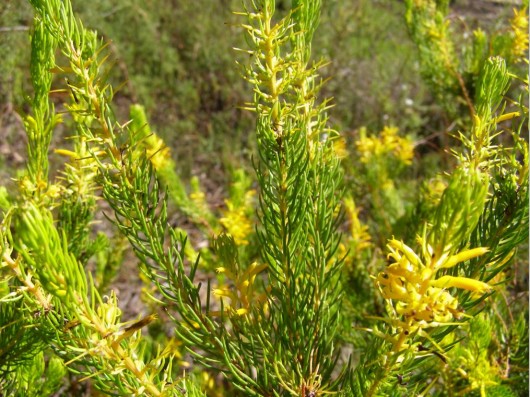 Blue Mountains Needle Geebung (Persoonia acerosa)
[Photo by Editor, 20130307, click image to enlarge, Photo © ^Creative Commons]
Listed as vulnerable to extinction in Schedule 2 ‘Vulnerable species and ecological communities‘
within the Threatened Species Conservation Act 1995 (New South Wales).
[Source: NSW Government, ^http://www.environment.nsw.gov.au/threatenedspecies/whatists.htm] Blue Mountains Needle Geebung (Persoonia acerosa)
[Photo by Editor, 20130307, click image to enlarge, Photo © ^Creative Commons]
Listed as vulnerable to extinction in Schedule 2 ‘Vulnerable species and ecological communities‘
within the Threatened Species Conservation Act 1995 (New South Wales).
[Source: NSW Government, ^http://www.environment.nsw.gov.au/threatenedspecies/whatists.htm]
.
The Needle Geebung is a plant species within the Proteaceae family of flowering plants. The Needle Geebung is a small, erect to spreading shrub 1 – 2 m tall. Its bright green, pine-like foliage is very distinctive. The small, needle-like leaves are channelled on the upper surface. Flower clusters are produced along leafy shoots, not at the branch tips, as in related species. The yellow tubular flowers are up to 1 cm long and most frequently appear in summer. Fruits are pear-shaped, yellowish-green with brownish-red markings, to 14 mm long and 10 mm in diameter.
.
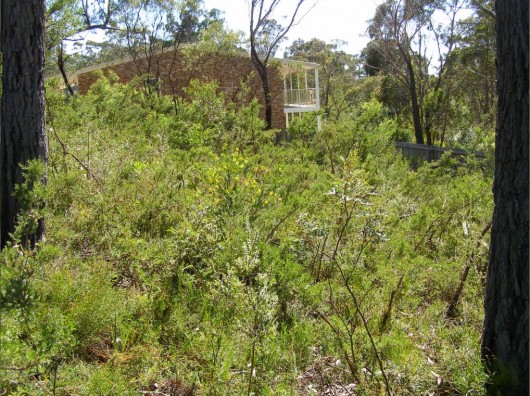 Needle Geebung in its natural setting (yellow flowers in centre of image)
[Photo by Editor, 20130307, click image to enlarge, Photo © ^Creative Commons] Needle Geebung in its natural setting (yellow flowers in centre of image)
[Photo by Editor, 20130307, click image to enlarge, Photo © ^Creative Commons]
.
The Needle Geebung occurs in dry sclerophyll forest, scrubby low-woodland and heath on low fertility soils. Plants are likely to be killed by fire and recruitment is solely from seed. This species seems to benefit from the reduced competition and increased light available on disturbance margins including roadsides.
The threatened status of this species was last assessed in September 2012, but as each month passes and more fringe bushland is flogged off for housing development, the existence of the species is further reduced.
In New South Wales, ‘threatened‘ species, populations and ecological communities are those respectivelyconsidered by the New South Wales Scientific Committee to be at risk of extinction in the immediate to medium-term future in New South Wales, and are listed under Threatened Species Conservation Act 1995, Schedules 1, 1A and 2.
[Source: New South Wales Government, ^http://www.environment.nsw.gov.au/threatenedspecies/whatists.htm]
.
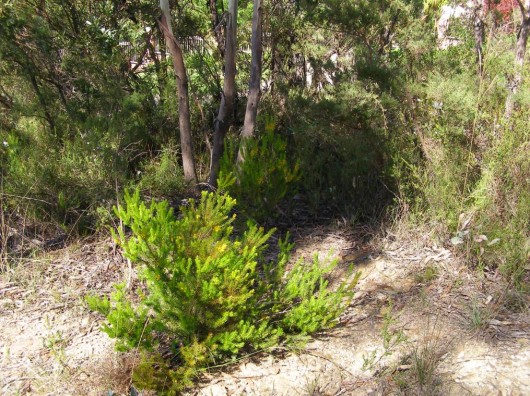 Needle Geebung isolated by the property developer
[Photo by Editor, 20130307, click image to enlarge, Photo © ^Creative Commons] Needle Geebung isolated by the property developer
[Photo by Editor, 20130307, click image to enlarge, Photo © ^Creative Commons]
.
The Needle Geebung has been recorded only on the central coast and in the Blue Mountains, from Mt Tomah in the north to as far south as Hill Top where it is now believed to be extinct. It is mainly concentrated in the Katoomba, Wentworth Falls and Springwood area of the mid to upper central Blue Mountains. The following map is only indicative of where the species grows naturally, but due to government withdrawal of environmental funding, species surveys are not conducted, let alone implementation of Species Recovery Plans or Threat Abatement Plans.
 Needle Geebung – indicative distribution map
[Source: New South Wales Government,
^http://www.environment.nsw.gov.au/threatenedspeciesapp/profile.aspx?id=10591] Needle Geebung – indicative distribution map
[Source: New South Wales Government,
^http://www.environment.nsw.gov.au/threatenedspeciesapp/profile.aspx?id=10591]
.
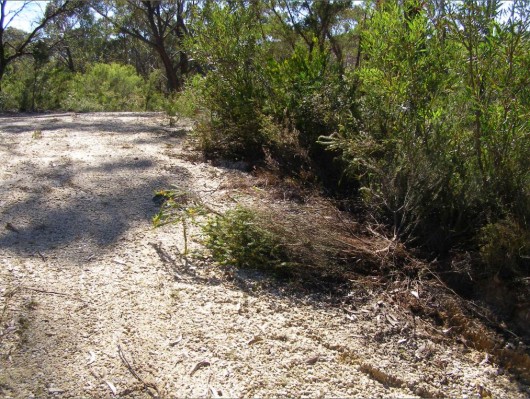 Property developer has killed a Needle Geebung on the site
[Photo by Editor, 20130307, click image to enlarge, Photo © ^Creative Commons] Property developer has killed a Needle Geebung on the site
[Photo by Editor, 20130307, click image to enlarge, Photo © ^Creative Commons]
.
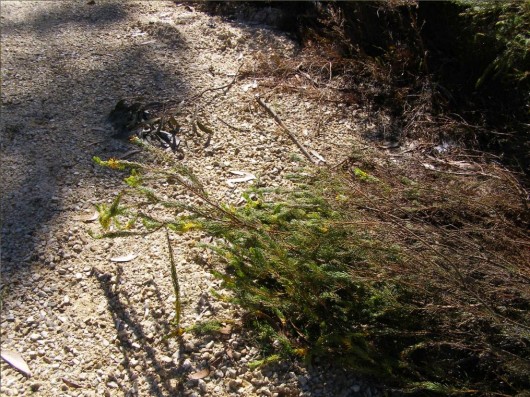 Close up of the same killed plant
[Photo by Editor, 20130307, click image to enlarge, Photo © ^Creative Commons] Close up of the same killed plant
[Photo by Editor, 20130307, click image to enlarge, Photo © ^Creative Commons]
.
The damage and killing of this particular plant and others on the site along Wellington Road was reported to the local statutory authority, the Blue Mountains Council on Friday 1st March 2013, following the discovery by local residents of the damage to this protected species. Council’s Customer Service Request reference is #174709.
Despite the previously undisturbed natural bushland on the site and the prolific concentration of Needle Geebung plants, the Council approved housing construction on the site about two weeks prior on 19 February 2013.
Such approval and the subsequent vegetation removal on the site and damage and killing of this species to the would seem to be a direct breach of the Threatened Species Conservatioin Act as it relates to protecting the Needle Geebung from harm. Under Section 91, Clause 1, the Director-General may grant a licence authorising a person to take action likely to result in one or more of the following:
.
(a) harm to any animal that is of, or is part of, a threatened species, population or ecological community,
(b) the picking of any plant that is of, or is part of, a threatened species, population or ecological community,
(c) damage to critical habitat,
(d) damage to habitat of a threatened species, population or ecological community.
.
Such harm is deemed and offence under the Act and can attract up to 200 penalty units or about $22,000 fine under Section 141E of the Act.
However, since reporting the incident, no action has been taken by Council and no fine imposed. The expression ‘paying lip service‘ comes to mine.
.
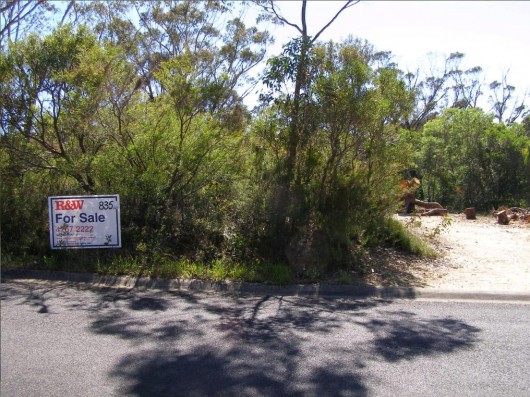 Real estate agents flogging Blue Mountains bush
[Photo by Editor, 20130307, click image to enlarge, Photo © ^Creative Commons] Real estate agents flogging Blue Mountains bush
[Photo by Editor, 20130307, click image to enlarge, Photo © ^Creative Commons]
.
Australia is estimated to be home to more than 500,000 animal and plant species. Many of which are found nowhere else in the world. Australia is faced with unprecedented loss of biodiversity. Over the last two hundred years, more than 100 species of animals and plants have become extinct. More mammals have died out in Australia, than in any other continent.
<<According to the International Union for Conservation of Nature and Natural Resources Red List of Threatened Species, Australia now has the highest rate of species extinction of any developed nation. Almost one in five mammal species are facing extinction and there are over 800 plants and animals which are listed as threatened.>>
[Source: 6.1 Threatened species and ecological communities, ^http://www.edo.org.au/edonsw/site/factsh/fs06_1.php]
.
The main causes of species’ decline include habitat destruction and degradation, impacts of introduced invasive species, pollution and disease. In New South Wales, there are more than 850 animal and plant species at risk of extinction – including the Koala, Humpback Whale and Wollemi Pine. Our ecosystems are also at risk. Only a small proportion of forests, woodlands and grasslands remain. The status of many thousands of species is unknown.
.
Under New South Wales Threatened Species Conservation Act 1995, Part 1, Section 3, the objects of the Act are:
.
(a) to conserve biological diversity and promote ecologically sustainable development, and
(b) to prevent the extinction and promote the recovery of threatened species, populations and ecological communities, and
(c) to protect the critical habitat of those threatened species, populations and ecological communities that are endangered, and
(d) to eliminate or manage certain processes that threaten the survival or evolutionary development of threatened species, populations and ecological communities, and
(e) to ensure that the impact of any action affecting threatened species, populations and ecological communities is properly assessed, and
(f) to encourage the conservation of threatened species, populations and ecological communities by the adoption of measures involving co-operative management.
.
[Source: New South Wales Government, ^http://www.legislation.nsw.gov.au/viewtop/inforce/act+101+1995+fn+0+N]
But unless diligent monitoring and enforcement supports the legistlation, such protection is effectively ‘paying lip service‘.
Here is the official lip service of the Blue Mountains Council as it relates to protecting Threatened Species in the Blue Mountains.
<<The Blue Mountains Local Government Area contains approximately 10% of the listed threatened species in New South Wales.
The high percentage is a function of the high biodiversity of the area, the large number of endemic species and the ongoing impacts of urban development such as land clearing, urban runoff, sedimentation, habitat disturbance, and weed invasion. Blue Mountains Council is committed to reversing this situation through sensitive urban planning, a strong environmental program, and targeted Environment Levy funded projects and by fostering community involvement in biodiversity conservation through the Bushcare, Landcare, Swampcare and Bush backyards programs.
Blue Mountains City Council employs a Biodiversity Conservation Officer who co-ordinates an integrated threatened species recovery team which focuses on threatened species which are endemic (ie only occurring in the Blue Mountains) or species that have a stronghold in the Blue Mountains including the Blue Mountains Water Skink, the Giant Dragonfly, the Dwarf Mountain Pine, Epacris hamiltonii, Leionema lachnaeoides and Eucalyptus copulans. The Biodiversity Conservation Officer is also responsible for raising awareness of threatened species and endangered ecological communities (EECs) such as Blue Mountains Swamp and Shale Based EECs in the Blue Mountains and fostering community involvement in their recovery.
How many threatened species occur in the Blue Mountains (as at June 2009)?
Vulnerable:
12 birds
14 mammals
3 amphibians
28 Plants (including the Needle Geebung)
1 Reptile
Endangered:
20 Plants
2 birds
1 amphibian
1 insect
2 mammals
2 reptiles
8 ecological communities
.
‘Vulnerable‘: a native species is considered ‘vulnerable’ if a species is likely to become endangered unless the threats to its survival cease to operate.
.
‘Endangered‘: a species is considered ‘endangered’ if it is in danger of extinction unless the threats to its survival cease to operate.
.
‘Presumed extinct‘: a species that has not been seen for more than 50 years despite thorough searching, is presumed extinct. Native species, populations and communities, which are presumed extinct, endangered or vulnerable in NSW, are all considered ‘threatened’.>>
.
[Source: Blue Mountains Council website, ^http://www.bmcc.nsw.gov.au/sustainableliving/environmentalinformation/threatenedspecies/]
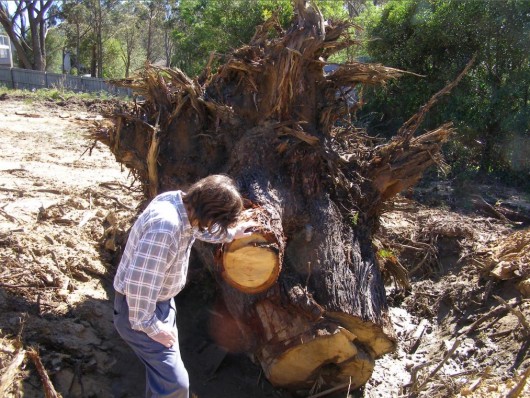 Mature Eucalypt 100+ years old killed for housing
[Photo by Editor, 20130307, click image to enlarge, Photo © ^Creative Commons] Mature Eucalypt 100+ years old killed for housing
[Photo by Editor, 20130307, click image to enlarge, Photo © ^Creative Commons]
.
.
A Lesson for Blue Mountains Greenwashing
.
2009: ‘Manager Fined for Environmental Offence’
.
<<In a recent case in NSW, the Land and Environment Court found the Director of Infrastructure at Port Macquarie Hastings Council guilty of an offence under the National Parks and Wildlife Act 1974 (Garrett v Freeman (No 5) [2009]). This is the first time that a senior council employee has been found guilty of an offence conducted while carrying out their normal work. The prosecution also shows that the Authorities are becoming more willing to target individual employees, rather than only their company or organisation.
The prosecution found that the Director had committed an offence under s 118D(1) of the National Parks and Wildlife Act 1974 (NPW Act). This section of the Act states that it is an offence to cause damage to the habitat of threatened species or endangered populations or endangered ecological communities. The maximum penalty for an offence against Section 118D(1) of the NPW Act is $110,000 or imprisonment for one year, or both. The recent court sitting, in which the penalty was determined, concluded with the Director being fined $57,000, as well as being directed to pay the prosecutor’s costs of $167,500.
As well as prosecuting the Director of Infrastructure, the Council was ordered to pay $45,500 plus $114,00 in prosecutor’s costs for an offence under the NPW Act and $35,000 and prosecutor’s costs of $80,000 for an offence under the Fisheries Management Act 1994 (NSW).
.
What lead to the decision?
.
The prosecution was made after the Director instructed access roads to be constructed within a wetlands, which was an area identified as having acid sulphate soils. The construction of the roads resulted in the disturbance of the habitats of two threatened species; the Grass Owl (Tyto capensis) and the Eastern Chestnut Mouse (Pseudomys gracilicaudatus).
The construction of the roads was found to be an activity within the meaning of Part 5 of the Environmental Planning and Assessment Act 1979 (EP&A Act), which requires that the environmental impact of an activity be considered prior to the activity being undertaken. The impact of the activity must be considered by the determining authority in approving the activity.
The Director did not obtain any approval for the construction of the access roads, and hence no determining authority was notified to assess the environmental impact of the activity. There was conflicting evidence surrounding whether the Director was aware that threatened species were present at the site, however it was concluded that he ought to have reasonably been aware, as a number of comprehensive studies to which he had access had identified the threatened species. The Director believed that he had conducted a Review of Environmental Factors for the site, which determined that there was no impact to threatened species. However the form of the Review did not constitute an assessment of the project’s impacts as required by the EP&A Act 1979, including the impact on the threatened species of the disturbance and destruction of their habitat.
The construction of the roads was found likely to significantly affect the environment or threatened species within the meaning the EP&A Act 1979. By undertaking the construction without obtaining an Environmental Impact Statement (EIS) or Species Impact Statement (SIS), council failed to comply with the requirements of the Act.
.
Key Factors
.
Evidence that lead to prosecution of the defendant included:
.
- The Director had actual knowledge that the roads were constructed
- The Director knew that the wetlands were habitat for the Grass Owl and the Eastern Chestnut Mouse, listed as threatened species
- The Director had actual knowledge, imputed knowledge, and/or constructive knowledge that the construction of the roads would damage threatened species habitat, specifically the Grass Owl and the Eastern Chestnut Mouse
- The Director failed to prove that he did not have knowledge that the council failed to comply with the EPA Act 1979
- The NPW Act requires the defendant to satisfy the Court that the principal offence was committed without his knowledge. The Director was unable to prove this to the satisfaction of the court. The case also found that there was ample evidence that the Council knew that the land was habitat of the two threatened species.
.
Lesson
.
… the precautionary principle always applies. If you suspect potential environmental impacts, you have a duty to ensure they are considered, whether there is sufficient information available about the impact or not. Ignoring the precautionary principle has been used as evidence for prosecutors in numerous past environmental litigation cases.>>
.
[Source: Noel Howard and Associates (risk management consultants), ^ http://www.noel-arnold.com.au/content/index.php?mact=News,cntnt01,detail,0&cntnt01articleid=197&cntnt01origid=69&cntnt01returnid=69]
.
 Blue Mountains Council – caring for country?
[Photo by Editor, 20130307, click image to enlarge, Photo © ^Creative Commons] Blue Mountains Council – caring for country?
[Photo by Editor, 20130307, click image to enlarge, Photo © ^Creative Commons]
.
.
Footnote
.
Response from Council..
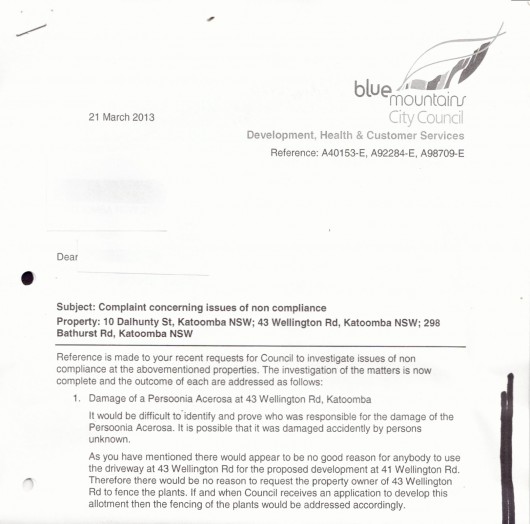 This is typical bureaucratic greenwashing to which Blue Mountains Council has developed into an artform to avoid its environmental responsibilty and to fob off any resident who dares to take an active interest in environmental protection. Some residents who complain about environmental pollution and damage too often are black listed, and are even cast with a punitive ‘Plan of Management’. This is typical bureaucratic greenwashing to which Blue Mountains Council has developed into an artform to avoid its environmental responsibilty and to fob off any resident who dares to take an active interest in environmental protection. Some residents who complain about environmental pollution and damage too often are black listed, and are even cast with a punitive ‘Plan of Management’.
The response has the same nonchalant disinterest and excuse that could well have instead read as follows:
‘Look resident 123456,
Frankly, this is again in our too hard basket and you should really stop contacting us and crawl back under your bush and leave us to do other things like write environmental reports, which we do well.
Yes, we sort of care about threatened species – our glossy brochures, reports, website and symposiums say so, and we believe them, but we don’t have time to get out there and actually check. We don’t have the resources.
Yeah, we have environmental protection by-laws, but we’re busy and anyway people need homes built. If we put too much environmental pressure on them their developers challenge us in the Land and Environment Court and usually win because we have weak laws and shit lawyers who love creaming ratepayers money. And so we don’t have the resources.
Since we can’t prove who killed the Persoonia plants, we put this matter in the category of ‘known unknowns’. We see that no-one else but the developer and his contractors had reason to use the driveway, so we see no reason for fencing out others since only the developer and his contractors would be damaging the Persoonia.
When they have finally cleared the block of all vegetation, and when the developer then thinks it is safe to lodge a development application to build with all plants removed, only then the fencing of the plants would be addressed accordingly.. if we get resource funding.
Signed Yours,
Pompous Arse (acting)
Development Monitoring Team (every second Tuesday of the third month*)
Development, Health & Custoner Services (on a completely separate floor to Council’s City & Community Outcomes Directorate which funnily enough includes environmental protection)
Please consider the Environment before photocopying this printed letter.
..the city within a world heritage national park
Blue Mountains Council (thinking it is a big city)
.
* Subject to staff availability and yes, resources.
.
Tags: Blue Mountains, caring for country, housing development, Living - Bushland Conservation, Mature Eucalypt killed, Needle Geebung, paying lip service, Persoonia acerosa, real estate land sales, Threatened Species Conservation Act, Vulnerable species and ecological communities, Wellington Road Katoomba
Posted in Blue Mountains (AU), Threats from Development, Threats from Greenwashing, Threats from Weak Environmental Laws | No Comments »
Add this post to Del.icio.us - Digg
Leave a Reply
You must be logged in to post a comment.
March 17th, 2013
[The following article was initially posted by Tigerquoll under the title “Basically a Fur Trade…”SKIN THE BEST and PLUCK THE REST” and published on 20091209 on ^candobetter.net]
.
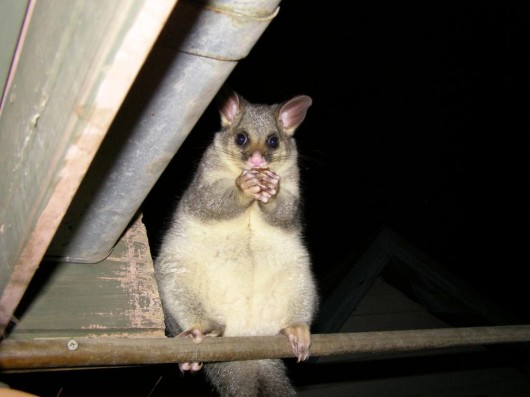 Brushtail Possum (Trichosurus vulpecula) a native to the Blue Mountains, Australia
(Photo by editor in winter, 20100606, click image to enlarge, © ^Creative Commons ) Brushtail Possum (Trichosurus vulpecula) a native to the Blue Mountains, Australia
(Photo by editor in winter, 20100606, click image to enlarge, © ^Creative Commons )
.
<<When the Australian Brushtail Possum was first released into New Zealand in 1837 (becoming successfully established around 1858) with the express purpose of establishing a fur trade, our colonial New Zealand forefathers had no idea of the terrible impact that possums would have on the delicate natural balance of the native New Zealand ecosystem.>>
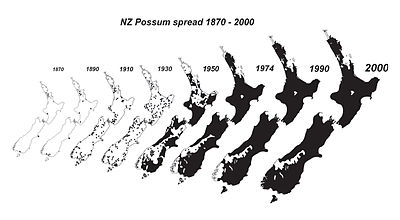 [Source: ‘The history of possums in New Zealand’,
^http://www.gorgeouscreatures.co.nz/NZ+Possum+Fur/Possum+History.html] [Source: ‘The history of possums in New Zealand’,
^http://www.gorgeouscreatures.co.nz/NZ+Possum+Fur/Possum+History.html]
.
On New Zealand’s North Island at the Bay of Plenty, a backyard possum fur trader, BASICALLY BUSH, runs a thriving business slaughtering Brushtail Possum for profit. It’s just like the good ol’ days of the 19th Century.
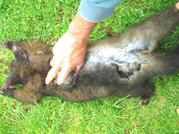
It seems the preferred kill method is by shooting…“Be careful not to get rubbish into the bag, and that you don’t end up dropping bullets or spent shells in.” But then they sell traps to possum poachers as well, so take your pick. Check out the possum trap called ‘Bushmaster No 1’:
 Steel Jaw Cruelty – NZ style Steel Jaw Cruelty – NZ style
.
A good sound trap, leg hold. Freight Costs incl GST: 1 – 12 traps: $6.50 12 – 24 traps: $17.00 24 – 48 traps: $25.00 48 – 96 traps: $65.00 Please add the cost of freight to your payment.
Basically Bush’s motto is “SKIN THE BEST and PLUCK THE REST”
It claims “this exciting raw material that has revolutionised the knitwear industry in New Zealand. Possum fibre is referred to as ‘possum merino’ and is promoted as ‘lighter than cashmere’.”
And profits are healthy. Back in 2007, “there has been a marked increase in fibre availability since we raised the price to $105/kg. “This increase was necessary to make sure that there was enough raw material to meet the needs of domestic production.”
 Not eradicating a feral animal population
But instead profiting and perpetuating an 1837 NZ Fur Trade Not eradicating a feral animal population
But instead profiting and perpetuating an 1837 NZ Fur Trade
.
These pest controllers have now gone international, making trips to India to promote fur sales, with brands like ‘Snowy Peak’ and ‘Woolyarns’.
Click here to meet the poaching team.
Colonial New Zealanders relocated Australian Brushtail Possums to New Zealand from the early 19th Century. Kiwi possum poaching currently just perpetuates the slaughter for the same reason as then – possum fur, not to eradicate them at all.
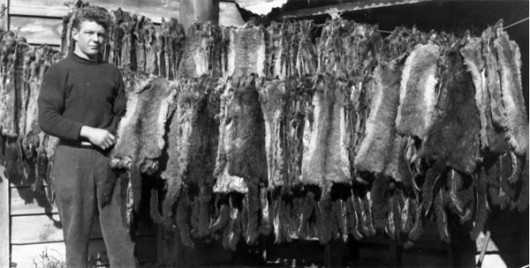
Anyone who takes exception to killing possums in large numbers (i.e the definition of ‘slaughter’) should be contributing alternatives. But profiteers like Basically Bush seem to be condoning the poaching practice. The numbers are not reducing, but the profiteers are making a killing. How backward!
What is the right way to remove introduced animals? It remains an avoided Kiwi ecological problem.
.
Illegal traps discovered in Makara bush
.
[Source: ‘Illegal traps discovered in Makara bush’, 20120731, Dominion Post, Wellington, New Zealand, ^http://www.stuff.co.nz/dominion-post/news/northern-suburbs/7384752/Illegal-traps-discovered-in-Makara-bush]
.
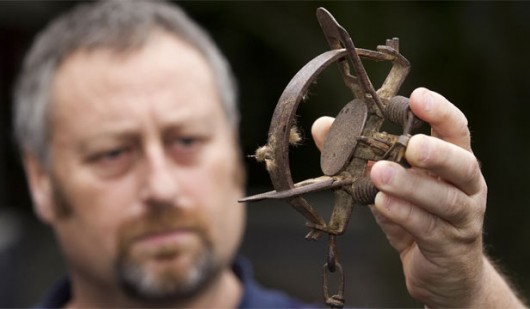 SPCA Inspector Ritchie Dawson with a banned inhumane possum trap
found in Makara Forest
(Photo by Maarten Holl) SPCA Inspector Ritchie Dawson with a banned inhumane possum trap
found in Makara Forest
(Photo by Maarten Holl)
.
Inhumane possum traps were discovered dotted throughout a Makara forest. A dead possum in an illegal trap dragged home by a family dog leading to the discovery of inhumane trapping on the block.
Brent Lyell Still, of Upper Hutt, was yesterday convicted of using the illegal traps.
Guy Holmes’ called the SPCA after his dog came home dragging a leg trap in August last year. Mr Holmes told the animal welfare inspectors he found 10 possums in traps and had to kill them. The SPCA found traps had been set on Mr Holmes’ land and his neighbour’s to catch possums.
Carcasses taken to a vet showed crush injuries that would cause distress and significant pain before death.
Mr Holmes had planted pine trees on his Makara Rd property intending to mill them and had never given permission for the traps to be set on the property.
Still, 45, yesterday pleaded guilty and was fined $300 and ordered to pay costs of $353.22 for illegally using size 1.5 leg traps, which were banned at the beginning of last year.
It was the first time someone has been prosecuted for using the illegal traps. The traps grab a possum, most often by the leg, which can be crushed.
A further charge of setting traps that could entrap companions animals like dogs and cats was withdrawn. Still had been asked by the neighbour to do the trapping but had laid several traps on Mr Holmes’ property as well. In three days he killed over 600 possums.
Still’s lawyer Tim Blake said Still had been trapping for 20 years and had not known the law had changed. Wellington District Court judge Bill Hastings agreed with Mr Blake that there had been little publicity about the recent law change but said ignorance of the law was no excuse.
Judge Hastings said despite possums being pests, there was still an obligation to treat them humanely. To set the traps in place, a nail is driven into the tree.
SPCA prosecutor Liz Hall said any nail found in a tree at a mill would result in all logs being rejected by a mill because of the dangers of metal going through machinery. Blake disputed there would have been any problem, saying the nail was set only a couple of inches from the ground and the trees would be cut down higher than that.>>
.
Leave a Reply
You must be logged in to post a comment.
March 12th, 2013
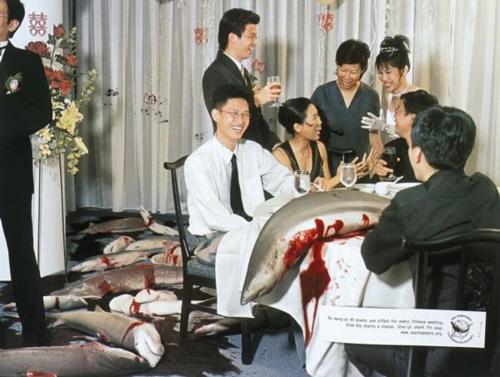 Chinese Shark Fin Soup is the barbaric dish of backward Chinese following a primitive custom from the ancient Ming Dynasty.
Many Chinese eat Shark Fin Soup at weddings and banquets out of superstition.
Sharks are caught by Chinese fishermen their fins hacked off while alive and the sharks thrown back into sea to die of a torturous death. Chinese Shark Fin Soup is the barbaric dish of backward Chinese following a primitive custom from the ancient Ming Dynasty.
Many Chinese eat Shark Fin Soup at weddings and banquets out of superstition.
Sharks are caught by Chinese fishermen their fins hacked off while alive and the sharks thrown back into sea to die of a torturous death.
.
Mar 2013: CITES Conference in Bangkok to decide on global Shark Finning Bans
.
<<World governments have agreed to restrict international trade in four shark species in a bid to save them from being wiped out due to rampant Chinese and Japanese demand for their fins.
The 178-member Convention on International Trade in Endangered Species (CITES) voted at a meeting in Bangkok to control exports of the oceanic whitetip and three types of hammerhead shark, but stopped short of a full trade ban. The move would require countries to regulate trade by issuing export permits to ensure their sustainability in the wild, otherwise they could face sanctions from CITES.
Asian nations led by Japan and China – where shark fin soup is considered a delicacy – tried in vain to block the proposals, which were pushed by countries including Brazil, Colombia and the United States.
The decision to add the species to CITES Appendix 2, which restricts cross-border trade, must still be formally approved by the conference’s plenary session later this week. Members would then have 18 months to introduce the trade controls.
The four species would join the great white shark, the whale shark and the basking shark, which already enjoy international trade controls. The Bangkok meeting was also set to vote on a similar proposal for the porbeagle shark and the manta ray.
Humans kill about 100 million sharks each year, mostly for their fins, according to the UN Food and Agriculture Organisation (FAO), and conservationists are warning that dozens of species are under threat. About 90 per cent of the world’s sharks have disappeared over the past 100 years, mostly because of overfishing in countries such as Indonesia, the FAO says.>>
.
[Source: ‘Protections aim to moderate trade in shark fins’, 20130311, AFP, ^http://www.abc.net.au/news/2013-03-11/protections-aim-to-moderate-trade-in-shark-fin/4566208]
.
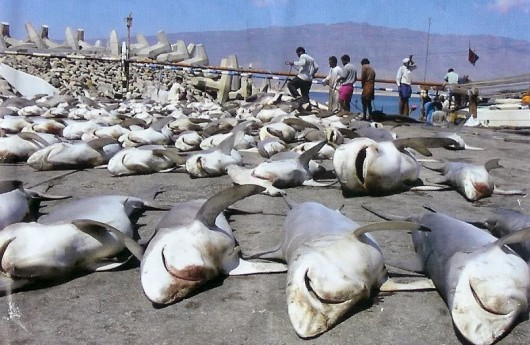 [Source: ^http://www.zmescience.com/ecology/americans-shark-finning-09082012/] [Source: ^http://www.zmescience.com/ecology/americans-shark-finning-09082012/]
.
<<Government representatives to CITES, have agreed to put the porbeagle, oceanic whitetip, three kinds of hammerhead shark and two kinds of manta ray on its Appendix II list, which places restrictions on fishing but still allows limited trade.
Joyce says “conservation groups have been trying for years to curtail the widespread killing of sharks for their meat and for shark fin soup.”
According to The Independent newspaper, scientists estimate that almost 100 million sharks are caught each year, and because they are slow-growing and slow to reproduce, they are especially vulnerable to overfishing.
“Although some regions, including the European Union, have banned shark finning, commercial fishing for fins, meat, liver oil, cartilage and other body parts is largely unregulated in much of the world, conservationists warn. Some countries have been reluctant to include marine species, which can generate large revenues, in the treaty that regulates or bans international trade in wildlife.
The shark fin business is worth an estimated $475 million a year.”>>
.
[Source: ‘International Convention Moves To Limit Shark ‘Finning’ Trade’, 20130311, by Scott Neuman, NPR, ^http://www.npr.org/blogs/thetwo-way/2013/03/11/174018120/international-convention-moves-to-limit-shark-finning-trade]
.
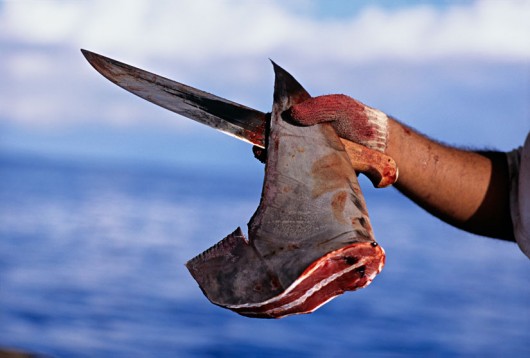 Shark Fin hacked off a live shark
so that backward Chinese can drink superstitious soup Shark Fin hacked off a live shark
so that backward Chinese can drink superstitious soup
.
Further Reading:
.
[1] Stop Shark Finning, ^http://www.stopsharkfinning.net/boycott-australia.htm
.
Leave a Reply
You must be logged in to post a comment.
March 10th, 2013
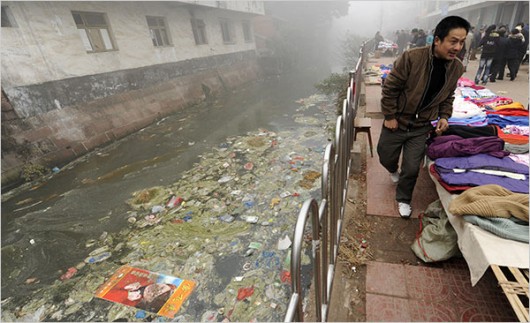 A heavily polluted river in the town of Zhugao in China’s southwest Sichuan province in 2010. A heavily polluted river in the town of Zhugao in China’s southwest Sichuan province in 2010.
Source: Peter Parks/Agence France-Presse — Getty Images
.
As economists drive growth, which is the only god they know, and lure China to becoming more westerised, China’s economy is under pressure to economically perform and keep up with the economic Jones’s. China now proudly has gained status as the world’s second-biggest economy.
 . .
But China’s economically global adage ‘Made in China‘ has come at a terrible cost to China’s environment, ecology and its people.
.
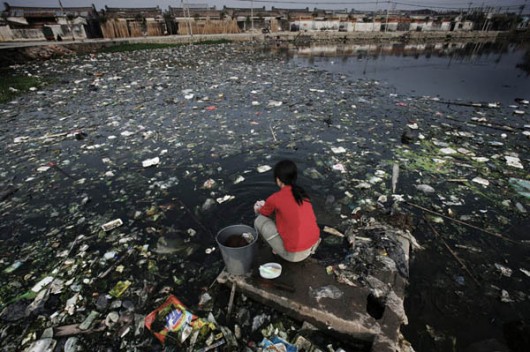 [Source: ^http://www.ecolatin.org/en/water-and-river-pollution-in-china-%E2%80%93-a-cotton-problem] [Source: ^http://www.ecolatin.org/en/water-and-river-pollution-in-china-%E2%80%93-a-cotton-problem]
.
<<One of China’s most critical environmental problems is water pollution.
.
Nearly 1/4 of Chinese lack access to clean drinking water, over 70 percent of lakes and rivers are polluted, and pollution accidents happen on a near daily basis.
.
Water pollution not only strains freshwater ecological health, but also severely impacts human health. Today, China has a growing cancer rate, with hundreds of “cancer villages” along the banks of polluted water sources. The World Health Organization recently estimated that nearly 100,000 people die annually from water pollution-related illnesses in China, and 75 percent of disease is linked to poor water quality.
China’s water pollution crisis made international headlines following a 2005 petro-chemical plant explosion which released 100 tons of benzene into the Songhua River. Such spills are not rare in China, yet the accident and ensuing cover-up opened new space for pressuring the Chinese government to change its approach to water pollution problems. Local, regional and national environmental groups now have more opportunity to establish themselves as watchdogs of government regulators and private industry.
Working with partners across China, Pacific Environment is reaching out to local communities concerned about water pollution and helping these communities conduct legal, public relations and advocacy campaigns to reduce the impacts of water pollution on public health and the local environment. Through these actions, our partners are playing a pivotal role to ensure clean water for China’s future.>>
.
[Source: ‘Water Pollution’, by Pacific Environment, ^http://pacificenvironment.org/section.php?id=373]
.
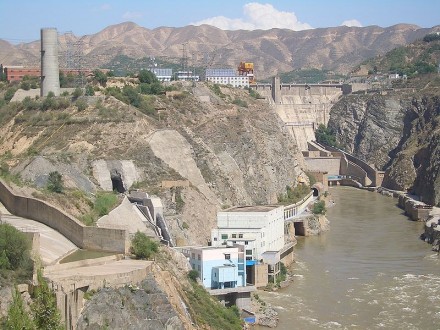 Liujiaxia Hydro Dam on the toxic Yellow River
China’s Gansu Province Liujiaxia Hydro Dam on the toxic Yellow River
China’s Gansu Province
.
<<In recent weeks (Feb 2013), Chinese and western media have been all atwitter over the shocking levels of air pollution in Beijing and a number of other Chinese cities. But it really shouldn’t be all that shocking. After all, in 2007, the World Bank and China’s own State Environmental Protection Administration (now the Ministry of Environmental Protection) found that that as many as 750,000 people die prematurely in China annually from respiratory disease related to air pollution.
And more recently, Greenpeace Beijing reported that in 2011 in four major cities, more than 8,000 people died prematurely as a result of just one pollutant, PM 2.5 [Particulate matter 2.5 – refers to tiny particles or droplets in the air that are two and one half microns or less in width]. Anyone who spends any time in Beijing knows that the city has not yet found a way to tackle the myriad sources of air pollution from construction to cars to coal.
.
According to one report, “up to 40 percent of China’s rivers were seriously polluted” and “20 percent were so polluted their water quality was rated too toxic even to come into contact with.”
.
As frightening as the country’s smog-filled skies might be, the country’s water pollution is easily as alarming. According to one 2012 report, “up to 40 percent of China’s rivers were seriously polluted” and “20 percent were so polluted their water quality was rated too toxic even to come into contact with.” Part of the explanation may rest in the “estimated 10,000 petrochemical plants along the Yangtze River and 4000 along the Yellow River.” (And the Yellow and Yangtze are not even the most polluted of China’s seven major rivers.) On top of whatever polluted wastewater might be leaching or simply dumped into China’s rivers from these factories, the Ministry of Supervision reports that there are almost 1,700 water pollution accidents annually. The total cost in terms of human life: 60,000 premature deaths annually.
While the macro picture is concerning, even more worrying is that individual Chinese don’t know whether their water is safe to drink or not. A Chinese newspaper, the Southern Weekly, recently featured an interview with a married couple, both of whom are water experts in Beijing (available in English here). They stated that they hadn’t drunk from the tap in twenty years, and have watched the water quality deteriorate significantly over just the past few years, even while state officials claim that more than 80 percent of water leaving treatment facilities met government standards in 2011.
It is difficult to get the straight story. According to one report by Century Weekly, there are a number of reasons for differing assessments of the country’s water quality:
.
- The frequency of testing at treatment plants is too low, and only 40 percent of the treatment plants in China’s thirty-five major cities have the capacity to test for all 106 indicators in any case
- There are only a few independent water-quality monitoring bureaus, and most water testing is done in-house by the same water-treatment plant being evaluated
- There is weak transparency from local governments as to the results of the tests,and,
- No water testing accounts for the contamination that occurs from the aging and degraded pipes through which the water is transmitted to Chinese households.
.
China’s environmental challenges are long in the making, not simply a function of the past thirty years of reform. As one reporter has noted, Beijing in the 1950s transformed from a city that “did not produce even pencils” to one that boasted “700 factories and 2000 blast furnaces belching soot in the air.”
In his 1991 book ‘Environmental Management in China‘, QuGeping, China’s first director of the country’s National Environmental Protection Agency, further commented about that time: “The environmental situation quickly deteriorated. A lot of places were polluted by either smog, sewage waters or rubbish. Biological resources, forests in particular, were seriously damaged, causing several losses to the ecosystem. There was extensive destruction of the natural environment of our country.”
In the 1950s, China, like other countries, neither understood well nor had the capacity to deal effectively with the environmental and health challenges its rapid development was creating. Today, however, China has both the knowledge and the capability. In the midst of the recent air pollution crisis, Premier-elect Li Keqiang said it would take time to address the air pollution problem: “There has been a long-term buildup to this problem, and the resolution will require a long-term process. But we must act.” In the meantime, the Chinese people can only wear their masks, buy their bottled water, and hope they are not in this year’s batch of pollution-related casualties.>>
.
[Source: ‘China’s Water Pollution Crisis’, 20130122, by Elizabeth C. Economy, The Diplomat, ^http://thediplomat.com/2013/01/22/forget-air-pollution-chinas-has-a-water-problem/ . Elizabeth C. Economy is C.V. Starr Senior Fellow and Director for Asia Studies at the Council on Foreign Relations. She is an expert on Chinese domestic and foreign policy and U.S.-China relations and author of the award-winning book, ‘The River Runs Black: The Environmental Challenge to China’s Future‘ She blogs at Asia Unbound, where this piece originally appeared.]
.
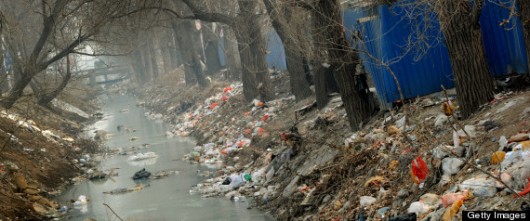 Trash clogs up a polluted canal at the edge of Beijing on March 16, 2012.
[Source: ‘Chinese Environmental Official Offered Reward To Swim In Polluted Ruian River’, 20120220,
by Sara Gates, The Huffington Post, Photo by Mark Ralston, AFP/Getty Images] Trash clogs up a polluted canal at the edge of Beijing on March 16, 2012.
[Source: ‘Chinese Environmental Official Offered Reward To Swim In Polluted Ruian River’, 20120220,
by Sara Gates, The Huffington Post, Photo by Mark Ralston, AFP/Getty Images]
.
<<China’s government on Tuesday (20100209) unveiled its most detailed survey ever of the pollution plaguing the country, revealing that water pollution in 2007 was more than twice as severe as was shown in official figures that had long omitted agricultural waste.
The first national pollution census, environmentalists said, represented a small step forward for China in terms of transparency. But the results also raised serious questions about the shortcomings of China’s previous pollution data and suggested that even with limited progress in some areas, the country still had a long way to go to clean its waterways and air.
The pollution census, scheduled to be repeated in 2020, took more than two years to complete. It involved 570,000 people, and included 1.1 billion pieces of data from nearly 6 million sources of pollution, including factories, farms, homes and pollution-treatment facilities, the government announced at a news conference.
But the comprehensiveness of the survey also resulted in stark discrepancies between some of the calculations and annual figures that the government has published in the past.
By far the biggest of these involved China’s total discharge as measured by chemical oxygen demand — the main gauge of water pollution, which measures chemical compounds in the water by checking how much oxygen they use. These discharges totalled 30.3 million tons in 2007, the census showed.
In recent years the Ministry of Environmental Protection has done a much narrower calculation of these discharges, excluding agricultural effluents like fertilizers and pesticides as well as fluids leaking from landfills. By that narrower measure, discharges came to only 13.8 million tons in 2007, which officials described at the time as a decline of more than 3 percent from 2006 and a “turning point.”
Zhang Lijun, the vice minister of environmental protection, sought to play down the differences with previous data. He noted that the census had counted 13.2 million tons of agricultural effluents for the first time, and 324,600 tons of discharges from landfills.
The census keepers had also used updated methodologies and reached many more parts of the countryside and industrial sites than had official statistics, which helped account for the much larger figure in the census, Mr. Zhang said. Were it not for the vastly expanded scope of the survey, the chemical oxygen demand level in 2007 would stand at only 5.3 percent higher than previously calculated, he said.
Ma Jun, director of the Institute of Public and Environmental Affairs, a nonprofit research group in Beijing, said that government planners had estimated that the country’s rivers and lakes could handle only 7.4 million tons a year of chemical oxygen demand. The scale and significance of agricultural effluent was seldom recognized in previous government planning, which focused on bringing down mainly industrial emissions to around 7 million tons a year from 13.8 million tons, said Mr. Ma, a leading expert on water pollution in China.
The new total of more than 30 million tons suggests a much bigger problem. “We believed we needed to cut our emissions in half, but today’s data means a lot more work needs to be done,” Mr. Ma said.
The extent of agricultural waste could prove a more intractable problem than that of the many factories dumping effluent into China’s rivers and lakes.
“When it’s millions of farmers, it’s more difficult to bring it under control,” Mr. Ma said.
Steven Ma, of the Beijing office of Greenpeace, said that the government’s decision to calculate and release figures for agriculture would have an effect on the policy debate over water pollution in China. “Everybody knew there was a problem with agricultural pollution in China, but now there are numbers,” he said.>>
.
[Source: ‘China Report Shows More Pollution in Waterways’, 20100209, by Jonathan Ansfield and Keith Bradsher (New York Times), Zhang Jing contributed research, Photo by Peter Parks (Agence France-Presse), ^http://www.nytimes.com/2010/02/10/world/asia/10pollute.html?_r=0]
.
.
Poisoned River – Gold Mining Along the Biliu River’
.
 Biliu River Sludge
(Liaoning Province, south-eastern China) Biliu River Sludge
(Liaoning Province, south-eastern China)
.
<<The Biliu River in Liaoning Province, whose source is near Yingkou City, empties into Bohai Sea at Dalian City. The upper stretch of the Biliu River is abundant in gold.
Villagers in this region for several years have been voicing their concerns regarding the impacts of gold mining on communities and the environment.
In response, in the summer of 2011, Blue Dalian conducted investigative trips to the upper Biliu River. Blue Dalian’s investigations revealed the region is impacted by six gold mines and seven gold separation plants. A total of three local companies are actively producing gold, while four companies that previously mined in the area have closed their operations. The report also includes data from publications produced by the Dalian Water Quality Supervision authority.
.
Gold: A Dirty Business
.
Gold mines in the upper Biliu River are subsurface hard rock mines, meaning rock which contains gold is dug from beneath the surface using tunnels. Once rocks are removed, two methods are used to extract gold: cyanide heap-leach and froth flotation. The cyanide heap-leach method involves leaching finely crushed rocks in cyanide liquid; cyanide binds to the gold which can then be separated out from the other materials in the rock. Froth flotation is also another chemical process used to separate gold from rock, and is generally used when gold is found in rocks that contain sulfides. Cyanide and other chemicals used in these processes are extremely toxic and can seriously threaten environmental and human health.
The primary negative environmental risks associated with these forms of gold processing include:
.
1. Human impacts: poisonous gases, dusts, and waste accumulation at and near the mining sites are harmful to the physical health of the local people and mine workers; water quality is impacted by the mines and there is risk of serious poisoning in the event of a mining waste pond failure.
2. Vegetation loss: development of mines and processing plants damages the ecology of the local landscape, including through removal of vegetation.
3. Geological and soil impacts: mines poison the soil, and soil loss is accelerated through erosion; landslides can be caused by digging or by accumulation of mining wastes, particularly if protective measures are not put in place.
4. Water impacts: water is diverted for use in the mines and is then no longer available to support ecological functions. Surface water pollution and underground water pollution is common, particularly through waste water leaks, which are likely in the event of heavy rains.
5. Wildlife impacts: waste water contains cyanide and other chemicals which are extremely poisonous and which may kill fish or other aquatic life.
.
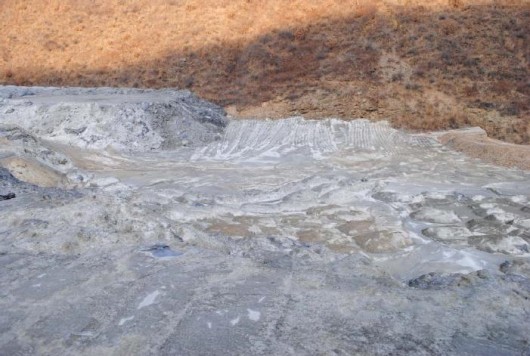
.
Biliu River Gold Mining Companies: a History of Negligence
.
There are three mining companies actively mining in the upper Biliu River watershed at present: Xinlong Mining Corporation, Futian Mining Corporation, and Futian Mining Corporation Flotation Factory.
Xinlong Mining Corporation, a local state-owned corporation, was visited by Blue Dalian during summer, 2011. According to the local Environmental Protection Bureau, the Xinlong Mining Corporation has accumulated more than 1,000 tons of waste residues at the site, far beyond the waste residue carrying capacity permitted. The investigation team observed piles of waste ore and accumulated waste residues held back by a low dam which were susceptible to being washed into the Biliu River in the event of a heavy rain.
The investigation team also learned that several years ago, waste residues directly leaked into Biliu River by the Xinlong Mining Corporation killed local livestock. Villagers living beside Xinlong Mining Corporation operations also told Blue Dalian that they have had difficulty selling their grain crops, due to concerns that the grain may be contaminated with heavy metals through contact with mine waste. Local people have tended to keep silent about these pollution issues because many of them work at the mine.
People living near Futian Mining Corporation operations told investigators about a suspected cyanide toxin accident. A massive fish kill occurred, and many residents developed thyroid problems, had difficulty breathing, and developed impaired eyesight. Local villagers insisted the government release data on water quality of the local river and information on the contents of the company’s waste water ponds, but the government never responded. The factory initially agreed to give monetary compensation to villagers whose health was impacted by the accident, but later broke that promise. Investigators learned from villagers who had connections inside the mine that no protective measures to prevent sewage containing cyanide from polluting the Biliu River were in place, though the company covers toxic residues with dirt so that they are out of sight of inspectors. The villagers now drink water from neighboring villages instead of the local groundwater they have relied upon for generations.
Primary Environmental and Human Health Concerns of Mining on the Biliu River
Threats to the health of local villagers: the Xinlong Mining Corporation uses cyanide heap leach method to extract gold, which produces waste water and residues that contain cyanide. Cyanide is extremely toxic and it is suspected villagers have already been poisoned.
Water environmental safety: gold mines along the upper Biliu River are located near tributaries to the river, and mine tailings ponds were found be located close to these tributaries. Tailings ponds were observed to be poorly located and managed, and their size and number was beyond the carrying capacity for the area. Further, dams used to contain the tailings are made from compressed earth and consequently are not water tight. According to Chinese safety standards for tailing pond construction, all the ponds observed along the Biliu River do not meet normal safety standards.
Government data shows that the water quality of the Biliu River is much lower than other sections of the river, especially for sulfate radicals, cyanide, and some heavy metals. Waste water samples collected from the Xinlong mine area were tested and found to contain more mercury and cyanide than is permitted for surface water. This is not surprising given mining waste water in this area flows directly into the Biliu River.
Heavy metal pollution in the soil: gold mining has led to the accumulation and compounding of many heavy metals – including arsenic, lead, cadmium, and zinc – in the soil environment in this area. Soil becomes polluted with heavy metals through leaks in the mine tailings ponds.
Drinking water safety in Dalian City: the Biliu River reservoir supplies Dalian City with a million tons of drinking water per day, which accounts for the overwhelming majority of the water supply in Dalian. During rain events, mine tailing in the upper watershed may directly leak into the Biliu River. The cyanide and heavy metals accumulated in these tailings may pollute the river, leading not only to local water quality impacts but a potential water crisis for Dalian City. There are already some cases in China where hundreds of people have been poisoned by water containing high amounts of cyanide which entered drinking water supplies after heavy rain storms.
.
Suggestions for Protection of the Upper Biliu River
.
1. Regular supervision of cyanide pollution and other heavy metal pollution along the upper Biliu River. The local environmental supervision department should regularly test cyanide content and other heavy metal content in the soil, surface water, and groundwater at and near the mining sites. At same time, the department should evaluate the risk of accidents and take protective measures.
2. Heavy metal cleanup and ecological recovery. Clean up and ecological recovery is needed to remove heavy metals and decrease the toxicity of the soil in and near the mines. This is important to the recovery of normal functions of soil ecosystem and reducing heavy metals being transmitted to the food chain and groundwater.
3. Establish an emergency water pollution accident mechanism in Dalian City. First, Dalian should store water in case of a water pollution emergency. A water reserve could reduce the dependence on the Biliu River and assure water supplies if an emergency happens. Second, an early warning system should be established. Related departments should punctually notify citizens to suspend water use and mobilize other water sources.
4. Strengthen integrated watershed management of the Biliu River. Dalian City should coordinate Biliu River management and development with upstream Yinkou City, which is heavily invested in mining in the upper watershed. Working together can help ensure that the river can be sustainably used and managed into the future, and that less resource intensive industries can be developed in the region.
5. Strengthening environmental supervision of mining companies. Regulators need to ensure companies improve production techniques in order to increase efficiency and reduce pollution, and that companies safely handle wastes and where possible, recycle some of the resources contained in the mining waste products.
.
[Source: ‘Poisoned River – Gold Mining Along the Biliu River’, 20111117, Pacific Environment, ^http://pacificenvironment.org/partner-report-poisoned-river—gold-mining-along-the-biliu-river–nov-2011ch]
.
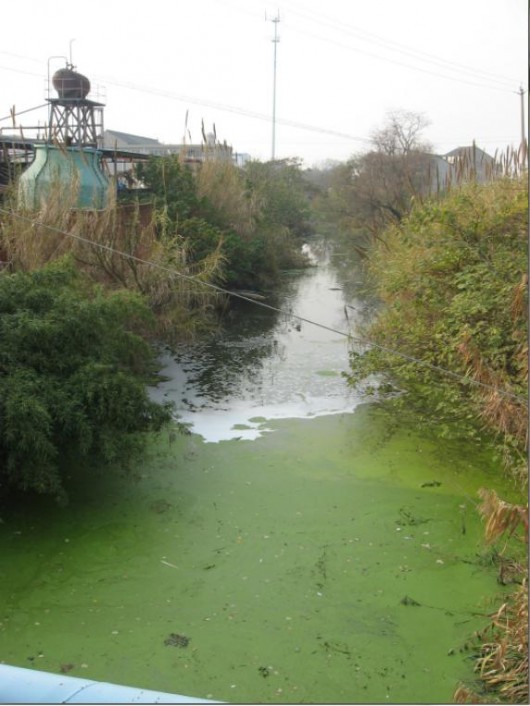 One of the many thousands of dead streams across China
[Source: ^http://www.dispatchesfromchina.com/2010/06/] One of the many thousands of dead streams across China
[Source: ^http://www.dispatchesfromchina.com/2010/06/]
.
The Sad Story of an Environmentalist in northeast China
.
<<Forty-five-year-old Lv Qingrong lives in a village 10 kilometers away from the Biliu River in southeast China. The family has lived in the village for 14 generations. In his childhood, Lv Qingrong and his friends played by the riverside catching fish and shrimp. By the river, there was a thick forest, visuals of which are deeply engraved in Lv Qingrong’s mind.
“There were lots of trees in the mountain and there lived all kinds of animals. In the river, you could find fish, turtles, shrimp and crabs. These memories are still so vivid and dear to me now.”
In 1984, when Lv Qingrong was 21, he retired from the army and returned to his hometown in the countryside of Yingkou city in Liaoning Province.
“At the time, there were very few trees left in the mountain and water levels in Biliu River dropped dramatically. There were garbage and sometimes dead animals along the river banks. I was so sad seeing all this.”
Lv Qingrong started his garbage collection efforts in 1984. One day in spring when Lv Qingrong and a relative passed the river bank on the way to work, he came across a pile of firecrackers abandoned near the river. “Let’s deal with this first,” he said to his relative.
He started collecting clearing out the pile of firecrackers. Later, it developed into a massive project to clean the river banks.
Since then, Lv Qingrong took several bags and went to pick garbage by the river. Even in the following years when everyone had a chance to make money thanks to the government’s reform and opening up policy, Lv Qingrong didn’t stop picking garbage. Many people, especially his family members, did not understand him and sometimes got irritated with him concentrating on something they thought was useless.
In July 28th, 1981, the village was hit by a mudslide in which 300 people were killed.
“Why did the mudslide happen? When forests are destroyed by practices such as burning vegetation for land reclamation, over grazing and cutting trees for firewood, soil is easily washed away without the cover of vegetation, and mudslides occur. It is human beings who destroy their own environment and life.”
When he realized that picking garbage was not a permanent solution, Lv Qingrong decided to plant trees on the mountain. In 2000, even though his family was against it, he contracted 23 hectare of deserted land in the mountain after taking a debt of 110,000 yuan. His wife started to quarrel with him after the family became dirt poor and the couple ended up getting a divorce in 2003. His youngest son had to leave home and work in a big city to fund his own education.
After the divorce, Lv Qingrong continued to work towards preserving the environment around the mountain area.
.
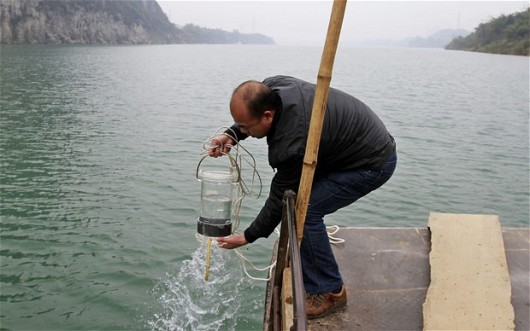 A man collects water samples from the polluted Longjiang River in Liuzhou, Guangxi Zhuang autonomous region. The authorities dumped hundreds of tons of aluminium chloride into the Longjiang River in an effort to dissolve tonnes of dumped cadmium.
[Source: ’20 tons of cadmium poisoning vital Chinese river’, 20120201, by David Eimer UK Telegraph (in Beijing),
^http://www.telegraph.co.uk/earth/environment/9053671/20-tons-of-cadmium-poisoning-vital-Chinese-river.html] A man collects water samples from the polluted Longjiang River in Liuzhou, Guangxi Zhuang autonomous region. The authorities dumped hundreds of tons of aluminium chloride into the Longjiang River in an effort to dissolve tonnes of dumped cadmium.
[Source: ’20 tons of cadmium poisoning vital Chinese river’, 20120201, by David Eimer UK Telegraph (in Beijing),
^http://www.telegraph.co.uk/earth/environment/9053671/20-tons-of-cadmium-poisoning-vital-Chinese-river.html]
.
“What made me sad were misunderstandings from other people, especially my family members. I sometimes doubted myself and wondered if I could keep going. But every time I came to the river, I became clear and focused again. I was sure that what I was doing was right, so I became determined to continue.”
In addition to bearing the brunt of people’s misunderstandings, Lv Qingrong was struggling in other ways at that time. Without any home appliances or decent furniture, Lv Qingrong couldn’t even afford a proper New Year’s dinner to celebrate China’s most important holiday; the Spring Festival.
“I was poor and alone on New Year’s eve. I couldn’t even afford a meal of dumplings because I had given all my money to the bank to pay the debt. I wrote a couplet to celebrate the festival. It said ‘I don’t eat dumplings because I don’t have money. There’s nothing I can do, but setting off a string of firecrackers to celebrate the New Year.'”
Lv Qingrong is a big fan of traditional Chinese poems and when he feels lonely or sad he also writes them. He has had more than 100 poems published in popular Chinese magazines and newspapers. His favorite writer is the ancient Chinese poet Po Chu-yi (白居易) who lived some 160 years ago and was best known for his ballads and satirical works. Lv Qingrong recites his favorite Po Chu-yi poem.
“Don’t say all the living beings are petty and low. They have the same flesh and blood. Please don’t kill the bird on the tree, Her fledglings are expecting their mother in the nest.”
.
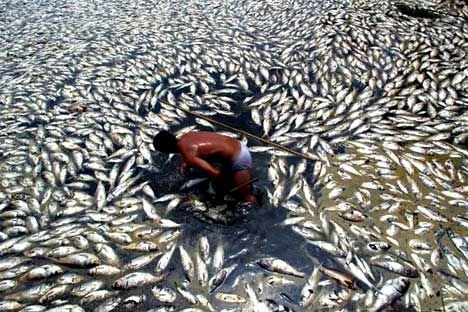 [Source: ^http://www.treehugger.com/corporate-responsibility/the-price-of-chinas-pollution-and-its-environmental-catch-22.html] [Source: ^http://www.treehugger.com/corporate-responsibility/the-price-of-chinas-pollution-and-its-environmental-catch-22.html]
.
Eight years have past since Lv Qingrong started to reforest the mountains and his efforts haven’t been in vain. The once deserted area is now covered with young trees and animals have returned. In the river people can see salamanders again, after they had almost become extinct.Contented with the results, Lv Qingrong still lives a poor life alone. Some people suggest he could make money by selling wood or breeding sheep.
However Lv Qingrong is reluctant to use anything from the mountain. So he is known as a poor millionaire who owns a goldmine but has not a penny to spend.Despite other people’s doubts, the environmentalist’ efforts continue. In 2006, he initiated the “Biliu River Water Resources Protection Association”. There are already 200 members, ranging from municipal officials to primary school students. They come from his hometown and from the neighboring cities of Yingkou and Dalian.
“The officials are more persuasive then I am when we go to spread environmental protection messages to students. Environment education should start with children. We teach them about garbage disposal and proper ways to deal with used batteries. The children have also learned to protect animals. The overall awareness of environmental protection will improve if we start to educate them.”
In order to increase awareness about river protection, Lv Qingrong has erected a monument at the source of the Biliu River and engraved water protection slogans along with an introduction to the history of the river. With more government attention nationwide on environmental protectionand with increasing interest from people in his hometown, everything seems have taken a turn for the better. Lv Qingrong’s eldest son, who’s in his early 20s, has been emulating his father when it comes to river protection.
“The protection of the environment has become a hot topic in our village. People often come to me and inquire about environmental issues. I’m happy more and more people have become involved.”
Forty-five-year-old Lv Qingrong is resolute in his dedication and focus.
“I will stay and keep watching the river for the rest of my life.”>>
.
[Source: ‘The Sad Story of An Environmentalist in Northeast China’, 20080921, by Wu Jia, CRIENGLISH.com, ^http://english.cri.cn/4026/2008/09/21/1241s407576.htm]
.

.
Tags: air pollution, Biliu River, chemical oxygen demand, China water pollution, China's environment, diseases, drinking water, Environmental Management in China, Gold Mining, growing cancer rate, Made in China, National Environmental Protection Agency, poisoned river, polluted Longjiang River, polluted river, toxic Yellow River, Yangtze River
Posted in Threats from Pollution | No Comments »
Add this post to Del.icio.us - Digg
Leave a Reply
You must be logged in to post a comment.
March 5th, 2013
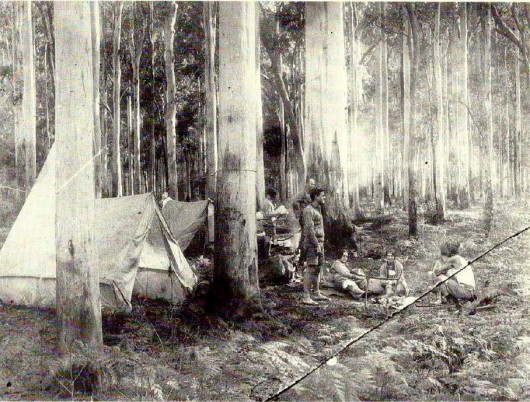 Blue Gum Forest in 1931
An innocent time in fading history – when Platypus were plentiful, bred and swum freely in the Grose River Blue Gum Forest in 1931
An innocent time in fading history – when Platypus were plentiful, bred and swum freely in the Grose River
Party of Sydney Bush Walkers in Blue Gum Forest, circa October 1931
[Source: Photo by Alan Rigby, Blue Gum Forest Committee,
from ‘Back from the Brink: Blue Gum Forest and the Grose Wilderness’ (1997), book by Andy Macqueen, p.256, click image to enlarge]
.
In 2006, the New South Wales (Government’s) Parks and Wildlife Service (NPWS) or ‘Parks‘, being delegated by the Australian Government for absolute responsibility for ecologically protecting the Blue Mountains World Heritage Area (BMWHA), so under-resourced its firefighting effort as to deliberately let the Grose Valley burn out of control.
Senior management well knew, like their firefighting partners the Rural Fires Service, that legal and political accountabilty extended ONLY to protecting private properties and human lives. So this they did and so let 14,070 hectares of the Grose Valley and adjoining land burn. It saved them the cost and effort of future ‘hazard’ reduction.
Parks adopted a cost-saving abandonment strategy (making management look efficient) which it labels deliberate bushfire as ‘fire ecology‘ and so by deliberate under-resourcing of fire fighting against two documented ignitions to then let burn into the Grose Valley and the Blue Gum Forest. These two ignitions (1) a purported lightning strike on Burra Korain Ridge and (2) a deliberate RFS ‘hazard’ reduction burn along the south side of Hartley Vale Road – both outside the BMWHA, were the instigators of the 2006 Grose Fire.
It was all hushed up, despite public calls for an independent public enquiry. Both the RFS Commissioner and Blue Mountains Local Member at the time said no to the public calls for an independent public enquiry. Why?
.
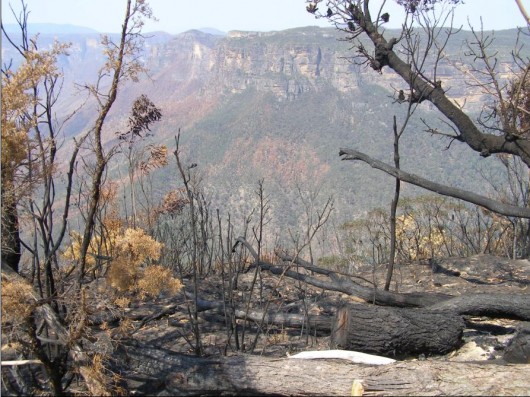 Grose Valley Fire aftermath at Govetts Leap, Blackheath Grose Valley Fire aftermath at Govetts Leap, Blackheath
[Photo by Editor 20061209, click image to enlarge, free in public domain]
.
New South Wales colonists, once they stumbled across the spectacular Grose Valley deep in the Blue Mountains, were in awe in sublime wonder. So it was that initially that the Grose Valley as far back as in 1875 became reserved as a ‘national spectacle’.
But many wanted to dam it – ^Robber Barons and prevailing industrialist politicians of the times had the same view of ‘progress‘ being a colonial right and unquestioningly superior to Nature. They tried to put the railway through the Grose, to mine it, to log it or else to farm it; all so long as the vast ‘resource’ was not neglected for ‘progress‘.
.
 Grose Valley, view from Govett’s Leap in 1886 by Charles Bayliss
Note the women in the foreground in the Victorian dress of the day
[Source: Part of Lindt, J. W. (John William), 1845-1926,
National Library of Australia, 1 digital photograph : b&w,
^http://nla.gov.au/nla.pic-vn3989404] Grose Valley, view from Govett’s Leap in 1886 by Charles Bayliss
Note the women in the foreground in the Victorian dress of the day
[Source: Part of Lindt, J. W. (John William), 1845-1926,
National Library of Australia, 1 digital photograph : b&w,
^http://nla.gov.au/nla.pic-vn3989404]
.
Thankfully, this majestic Grose Valley and its ancient icon Blue Gum Forest were saved the axe in 1931. But is was only marginally due to the persistent campaigning efforts of a small dedicated group of bushwalkers passionate about saving this forest back even in the midst of The Great Depression.
If ever a case were not truer:
“Never doubt that a small group of thoughtful, committed people can change the world. Indeed, it is the only thing that ever has.”
~ American cultural anthropologist, Margaret Mead
. Margaret Mead, 1901–1978 Margaret Mead, 1901–1978
.
‘The Blue Gum‘ was ultimately saved by the generous personal donation by allied bushwalker W.J. Cleary of £80 [perhaps $20,000 in today’s value *] to purchase the rights to the land from the pastoralist Clarrie Hungerford in February 1932.
.
Significantly, their dedicated act of environmental conservation is arguably the first environmental campaign in Australia’ history. ‘The Blue Gum‘ since then and for eighty years since has been affectionately known amongst environmentalists as ‘The Cradle of Conservation‘.
[Ed: * CALCULATION: In 1930, the average yearly wage for ordinary Australian workers was roughly £220, source: ^http://guides.slv.vic.gov.au/content.php?pid=14258&sid=95522. So given that today’s average yearly salary in Australia is about $56,000 (Source: ^http://www.abs.gov.au), the calculation is 80/220 * 56,000 = $20,000]
.
<<Everyone has been to the lookouts. Many have been to the Blue Gum Forest, deep in the valley– but few know the remote & hidden recesses of the labyrinth beyond. Here, an hour or two from Sydney, is a very wild place.
The Grose has escaped development. There have been schemes for roads, railways, dams, mines & forestry, but the bulldozers have been kept out. Instead, the valley became the Cradle of Conservation in New South Wales when it was reserved from sale in 1875 – an event magnificently reinforced in 1931 when a group of bushwalkers were moved to save the Blue Gum Forest from the axe.
Local author, Andy Macqueen, has been an enthusiastic bushwalker and conservationist since the 1960’s. In 1997, he published his book, ‘Back from the Brink: Blue Gum Forest and the Grose Wilderness‘, aptly titled in telling the true story of how the Blue Gum Forest was saved from destruction.
Macqueen’s well researched book tells in detail the story of the whole Grose Wilderness experience and of the Blue Gum Forest rescue story in particular. It tells about the many different people who have visited this wilderness: Aborigines, explorers, engineers, miners, track builders, bushwalkers, canyoners, climbers…those who have loved it, and those who have threatened it.>>
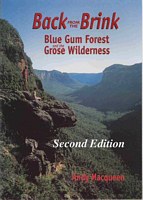 Available from Megalong Books, Leura in the Blue Mountains
^http://shop.megalongbooks.com.au/bookweb/details.cgi?ITEMNO=9780646476957
^http://www.megalongbooks.com.au/ Available from Megalong Books, Leura in the Blue Mountains
^http://shop.megalongbooks.com.au/bookweb/details.cgi?ITEMNO=9780646476957
^http://www.megalongbooks.com.au/
.
Other books about the Blue Mountains:
^http://www.lamdhabooks.com.au/bluemountainscatalogue.htm
.
Hazard Reduction Revenge
.
A decade later, in 1940 the Grose Valley was subjected to a bushfire; however its cause, circumstances and extent of damage are unknown by The Habitat Advocate.
This bushfire occurred only a year after the devastating 1939 Bushfires of ‘Black Friday‘ across Victoria, which is collectively considered one of the worst natural bushfires (wildfires) in the world. Almost 20,000 km² (2 million hectares) was burnt, 71 people perished and several significant native forests were destroyed (Victorian Alps, Yarra Ranges, Otway Ranges, Grampians and Strzelecki Ranges) and the townships of Dromana, Healesville, Kinglake, Marysville, Narbethong, Warburton, Warrandyte, Yarra Glen, Hill End, Nayook West, Matlock, Noojee, Omeo, Woods Point, Pomonal and Portland.
The subsequent Royal Commission, under Judge L.E.B Stretton (known as the Stretton Inquiry), attributed blame for the fires to careless burning, such as for campfires and land clearing.
It was the second major bushfire tragedy since the 1851 Black Thursday Bushfires which wiped out 5 million hectares of Victoria.
.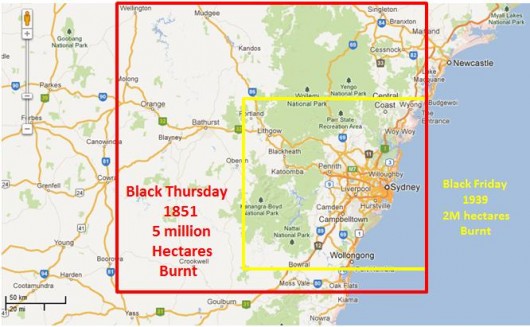 Bushfire Tragedy in aggregated geographical context.
So why are Australian wildlife hard to find in their natural bush habitat? Bushfire Tragedy in aggregated geographical context.
So why are Australian wildlife hard to find in their natural bush habitat?
.
More recently a disturbing ‘bushphobic culture‘ has produced a need to burn it for its burning sake. One must wonder whether our society has indeed advanced, matured or just ‘progressed‘ its colonialism?
.
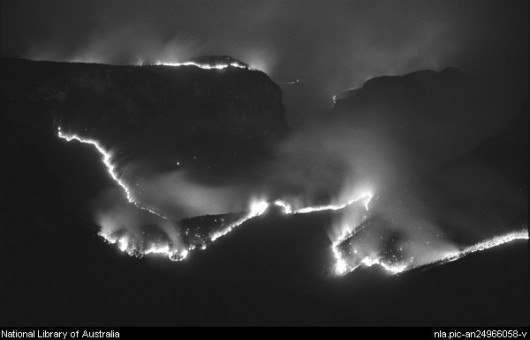 Grose Valley Bushfire of 25th October 2002
[Source: Image by Paul Cosgrave, National Library of Australia, 2003,
1 digital photograph : b&w.http://nla.gov.au/nla.pic-an24966058] Grose Valley Bushfire of 25th October 2002
[Source: Image by Paul Cosgrave, National Library of Australia, 2003,
1 digital photograph : b&w.http://nla.gov.au/nla.pic-an24966058]
.
In 2006, the Grose Valley was incinerated in a massive firestorm and this time the fire ripped through the Blue Gum Forest..
.
.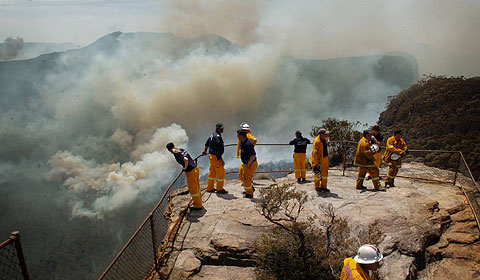 Firefighters watching the escalating bushfire incinerating the Grose Valley below
22 November 2006 – the day before the Grose Firestorm
Picture: Brad Newman, in The Australian. Firefighters watching the escalating bushfire incinerating the Grose Valley below
22 November 2006 – the day before the Grose Firestorm
Picture: Brad Newman, in The Australian.
.
<<Residents in towns across NSW waited for the worst last night as bushfires burned thousands of hectares across the state and dry conditions were forecast for almost the entire continent for another week.
Spot fires from a 10-day-old bushfire burning in the Blue Mountains came within a few hundred metres of houses in Blackheath. Katoomba, Mount Tomah and Lawson and other towns in the region were also under threat from the worst bushfire in the nation.
“There was virtually no cloud over the entire continent,” said Julie Evans from the NSW Bureau of Meteorology of the dry conditions expected to continue across most of Australia in the coming week.
As mild weather and a cool change provided relief to firefighters in South Australia and Victoria, smoke from the Blue Mountains blaze, which was last night largely contained in the Grose Valley, rose more than 12km into the air, causing ash to fall on central Sydney and effectively creating its own weather system.
Watching from a helicopter above the flames, National Parks and Wildlife Service acting regional manager Kim De Govrik said the explosion as the fire crowned in the tree-tops around the Banks Wall cliff-face was “like a nuclear bomb going off”.
Sparks ignited fires up to 15km away, near Faulconbridge, home of Rural Fire Service Commissioner Phil Koperberg, who is directing the operation to contain the state’s fires.
“By tomorrow morning, it wouldn’t be unreasonable to expect that there will be additional fires around the countryside,” Mr Koperberg said yesterday.
About 2000 firefighters spent the day battling about 44 fires across NSW, five of which the RFS said it was unable to contain. Molong enjoyed a reprieve after a late wind shift caused a fire to change direction just 4km from the central-western town. Residents were relocated to a community centre last night, while an unoccupied house and vehicle were destroyed by the fire.
The RFS met residents in the Hawkesbury and Goulburn regions early last night to update them on the fires and what they can do to prepare their homes.
The bushfires also led to blackouts across Sydney. Just a week after the city endured its coldest November night in a century, the city sweltered through its third-hottest November day in 25 years — the official maximum temperature was 38.4C. Dozens of suburbs in the city’s west and southwest were affected by the outages, as were large sections of the CBD.
The NSW parliament was twice plunged into darkness as the power surges hit in the late afternoon, with the second one lasting several minutes.
Mild weather led the bushfire threat across South Australia to fall. CFS spokeswoman Krista St John said the state’s southeast had been hardest hit, with fires burning about 8500ha.
In Victoria, a cool change helped firefighters bring the state’s larger fires under control, although lightning strikes ignited several smaller fires in the west of the state.>>
.
[Source: ‘Fires and dry conditions have residents fearing the worst’, 20061123, by Dan Box and Simon Kearney; additional reporting by Padraig Murphy and AAP, The Australian newspaper, ^http://www.theaustralian.com.au/news/fires-and-dry-conditions-have-residents-fearing-the-worst/story-e6frg6o6-1111112569927]
.
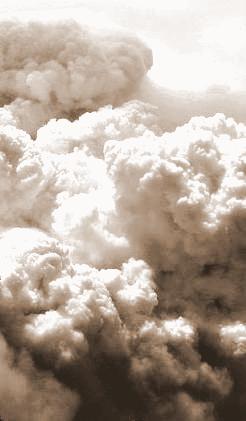 23 November 2006
14,070 hectares of precious Blue Mountains habitat incinerated
So why are Australian wildlife hard to find in their natural bush habitat? 23 November 2006
14,070 hectares of precious Blue Mountains habitat incinerated
So why are Australian wildlife hard to find in their natural bush habitat?
.
 The home that Parks had it in for … the Blue Gum Forest’s fire-scarred trees,
some of which have graced the Grose Valley for hundreds of years.
The home that Parks had it in for … the Blue Gum Forest’s fire-scarred trees,
some of which have graced the Grose Valley for hundreds of years.
A defacto hazard reduction burn.
[Photo: Nick Moir, ^http://www.nickmoirphoto.com/]
.
<<More than 70 years ago this forest inspired the birth of the modern Australian conservation movement. Today Blue Gum Forest stands forlorn in a bed of ash.
But was it unnecessarily sacrificed because of aggressive control burning by firefighters focused on protecting people and property? That is the tough question being asked by scientists, fire experts and heritage managers as a result of the blaze in the Grose Valley of the upper Blue Mountains last month.
As the fate of the forest hangs in the balance, the State Government is facing demands for an independent review of the blaze amid claims it was made worse by control burning and inappropriate resources.
This comes against a backdrop of renewed warnings that Australia may be on the brink of a wave of species loss caused by climate change and more frequent and hotter fires. There are also claims that alternative “ecological” approaches to remote-area firefighting are underfunded and not taken seriously.
In an investigation of the Blue Mountains fires the Herald has spoken to experienced fire managers, fire experts and six senior sources in four agencies and uncovered numerous concerns and complaints.
* It was claimed that critical opportunities were lost in the first days to contain or extinguish the two original, separate fires.
* Evidence emerged that escaped backburns and spot fires meant the fires linked up and were made more dangerous to property and heritage assets – including the Blue Gum Forest. One manager said the townships of Hazelbrook, Woodford and Linden were a “bee’s dick” away from being burnt. Another described it as “our scariest moment”. Recognising the risk of the backburn strategy, one fire officer – before the lighting of a large backburn along the Bells Line of Road – publicly described that operation as “a big call”.
It later escaped twice, advancing the fire down the Grose Valley.
.
- Concerns were voiced about the role of the NSW Rural Fire Service Commissioner, Phil Koperberg.
- Members of the upper Blue Mountains Rural Fire Service brigades were unhappy about the backburning strategy.
- There were doubts about the mix and sustainability of resources – several senior managers felt there were “too many trucks” and not enough skilled remote-area firefighters.
- Scientists, heritage managers and the public were angry that the region’s national and international heritage values were being compromised or ignored.
- There was anecdotal evidence that rare and even common species were being affected by the increased frequency and intensity of fires in the region.
- Annoyance was voiced over the environmental damage for hastily, poorly constructed fire trails and containment lines, and there were concerns about the bill for reconstruction of infrastructure, including walking tracks.
.
The fire manager and ecologist Nic Gellie, who was the fire management officer in the Blue Mountains for the NSW National Parks and Wildlife Service during the 1980s and ’90s, says the two original fires could have been put out with more rapid direct attack.
“Instead, backburning linked up the two fires and hugely enlarged the fire area … what we saw would be more accurately described as headfire burning, creating hot new fire fronts. While it protected the town of Blackheath, the plateau tops burnt intensely – and that created new problems both for management of the fire and the protection of biodiversity.
“When extreme fire weather, hot days and high winds arrived as predicted, the expanded fire zone was still not fully contained – and that was the cause of most of the high drama and danger that followed.”
In that dramatic week, Mr Gellie confronted Mr Koperberg with his concerns that the commissioner was interfering with the management of the fire by pushing hard for large backburns along the northern side of towns in the Blue Mountains from Mount Victoria to Faulconbridge, along what is known in firefighting circles as the “black line”.
The Herald has since confirmed from numerous senior sources that “overt and covert pressure” from head office was applied to the local incident management team responsible for fighting the fire.
There were also tensions relating to Mr Koperberg’s enthusiasm for continuation of the backburning strategy along the black line – even when milder weather, lower fuel levels and close-in containment were holding the fire.
Several sources say the most frightening threat to life and property came as the fire leapt onto the Lawson Ridge on “blow-up Wednesday” (November 22) – and that those spot fires almost certainly came from the collapse of the convection column associated with the intensification of the fire by the extensive backburns.
.
The Herald has also confirmed that:
- The original fire lit by a lightning strike near Burra Korain Head inside the national park on Monday, November 13, could not be found on the first day. The following day, a remote area fire team had partly contained the fire – but was removed to fight the second fire. The original fire was left to burn unattended for the next couple of days;
.
- An escaped backburn was responsible for the most direct threat to houses during the two-week emergency, at Connaught Road in Blackheath. However, at a public meeting in Blackheath on Saturday night, the Rural Fire Service assistant commissioner Shane Fitzsimmons played down residents’ concerns about their lucky escape. “I don’t want to know about it. It’s incidental in the scheme of things.”
.
Mr Koperberg, who is retiring to stand as a Labor candidate in next year’s state elections, rejected the criticisms of how the fire was fought. He told the Herald: “The whole of the Grose Valley would have been burnt if we had not intervened in the way we did and property would have been threatened or lost. We are looking at a successful rather than an unsuccessful outcome.
“It’s controversial, but this is world’s best backburning practice – often it’s the only tool available to save some of the country.”
The commissioner rejected any criticism that he had exerted too much influence. “As commissioner, the buck stops with me. I don’t influence outcomes unless there is a strategy that is so ill-considered that I have to intervene.”
Mr Koperberg said it was “indisputable and irrefutable” that the Blue Mountains fire – similar to fires burning now in Victoria – was “unlike any that has been seen since European settlement”, because drought and the weather produced erratic and unpredictable fire behaviour.
The district manager of the Blue Mountains for the Rural Fire Service, Superintendent Mal Cronstedt, was the incident controller for the fire.>>
.
[Source: ‘The ghosts of an enchanted forest demand answers’, 20061211, by Gregg Borschmann, Sydney Morning Herald, p.1, ^http://www.smh.com.au/news/national/the-ghosts-of-an-enchanted-forest-demand-answers/2006/12/10/1165685553891.html?page=fullpage#contentSwap2]
.
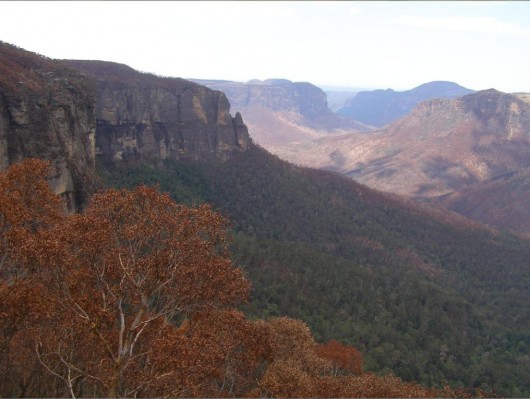 Grose Valley’s bushphobic habitat incinerated
because in the minds of Parks and the Rural Fire Service it was a fuel hazard
Click image to enlarge,
Photo by Editor 20070106, free in public domain Grose Valley’s bushphobic habitat incinerated
because in the minds of Parks and the Rural Fire Service it was a fuel hazard
Click image to enlarge,
Photo by Editor 20070106, free in public domain
.
<<A bushfire scars a precious forest – and sparks debate on how we fight fire in the era of climate change, writes Gregg Borschmann.
The ghosts of an enchanted forest demand answers
“Snow and sleet are falling on two bushfires burning in the Blue Mountains west of Sydney.”
ABC Radio, November 15: The news report was almost flippant, something that could happen only in Dorothea Mackellar’s land of drought and flooding rains. Later that evening, two weeks from summer, Sydney had its coldest night in more than a century.
Over the past month – as an early summer collided with a late winter and a decade-long drought – NSW and Victoria have battled more than 100 bushfires.
But of them all, last month’s Blue Mountains blaze reveals tensions and systemic problems that point to a looming crisis as bushfire fighters struggle to protect people, property, biodiversity and heritage values in a world beset by climate change.
The tensions have always been there – different cultures, different ways of imagining and managing the landscape. Perhaps they are illustrated by a joke told by two Rural Fire Service crew in the Blue Mountains. “How does the RFS put out a fire in your kitchen? By backburning your sitting room and library.” The joke barely disguises the clash between the imperative of saving lives and homes, and the desire to look after the land, and the biodiversity that underpins our social and economic lives.
For fire managers, whose first priority will always be saving people and property, the equation has become even more tortured with a series of class actions over fires in NSW and the ACT. As one observer put it: “These guys are in a position where they’re not going to take any chances. No one will ever sue over environmental damage.”
For bushfire management the debate tentatively started a couple of decades ago. The challenge was to do what poets, writers and painters have long grappled with – coming to terms with a country whose distinctiveness and recent evolutionary history have been forged in fire.
Drought and climate change now promise to catapult that debate to centre stage.
It is perhaps no accident that such a defining fire has occurred in one of the great amphitheatres of the Australian story, the Grose Valley in the upper Blue Mountains. Charles Darwin passed by on horseback in 1836, and described the valley as “stupendous … magnificent”.
The Grose has long been a microcosm of how Australians see their country. In 1859 some of the first photos in Australia were taken in the valley. Proposals for rail lines and dams were forgotten or shelved. The first great forest conservation battle was fought and won there in 1931-32.
But now the valley is under threat from an old friend and foe – fire.
Ian Brown has worked on dozens of fires in the Blue Mountains. He is a former operations manager for the National Parks and Wildlife Service.
“All fires are complex and difficult, and this sure was a nasty fire … But we need lots of tools in the shed. Those hairy, big backburns on exposed ridges so close to a blow-up day with bad weather surprised me. Frightened me even.”
For Brown, even more worrying is the trend.
“Parts of the Grose have now burnt three times in 13 years and four times in 24 years. Most of those fires started from arson or accident. Many of the species and plant communities can’t survive that sort of hammering.”
Ross Bradstock, a fire ecologist, agrees. Professor Bradstock is the director of the new Centre for the Environmental Risk Management of Bushfires at the University of Wollongong, which is funded by the Department of Environment and Conservation and the Rural Fire Service. He says Australia stands out as one of the countries whose vegetation may be most affected by climate change.
Bradstock says that in south-eastern Australia the potential for shifts in fire frequency and intensity are “very high … If we’re going to have more drought we will have more big fires.”
But the story is complicated and compounded by the interaction between drought and fire. The plants most resistant to fire, most able to bounce back after burning, will be most affected by climate change. And the plants that are going to be advantaged by aridity will be knocked over by increased fire frequency. “In general, the flora is going to get whacked from both ends – it’s going to be hit by increased fire and climate change. It’s not looking good.”
Wyn Jones, an ecologist who worked for the wildlife service, says the extremely rare drumstick plant, Isopogon fletcheri, is a good example. There are thought to be no more than 200 specimens, restricted to the upper Grose. Last week, on a walk down into the Blue Gum Forest, Jones found three – all killed by the fire.
The NSW Rural Fire Service Commissioner, Phil Koperberg, has been a keen supporter of Bradstock’s centre. Asked if he agreed with the argument that the Grose had seen too much fire, Mr Koperberg replied: “It’s not a comment I disagree with, but had we not intervened in the way we did, the entire Grose Valley would have been burnt again, not half of it.”
The great irony of the fire is that it was better weather, low fuels and close-in containment firefighting that eventually stopped the fire – not big backburns.
Remote area firefighting techniques have been pioneered and perfected over recent decades by the wildlife service. In 2003 a federal select committee on bushfires supported the approach. It recommended fire authorities and public land managers implement principles of fire prevention and “rapid and effective initial attack”.
Nic Gellie, a fire ecologist and former fire manager, has helped the wildlife service pioneer ecological fire management. The models are there – but he says they have not been used often enough or properly.
Doubts have been expressed about the sustainability of the current remote area firefighting model. It is underfunded, and relies on a mix of paid parks service staff and fire service volunteers. Most agree the model is a good one, but not viable during a longer bushfire relying on volunteers.
The Sydney Catchment Authority pays $1 million for Catchment Remote Area Firefighting Teams in the Warragamba water supply area. It has always seemed like a lot of money. But it looks like a bargain stacked against the estimated cost of $10 million for the direct costs and rehabilitation of the Grose fire.
Curiously, one unexpected outcome of the great Grose fire may be that the valley sees more regular, planned fire – something the former wildlife service manager Ian Brown is considering.
“If climate change means that the Grose is going to get blasted every 12 years or less, then we need more than just the backburning strategy. We need to get better at initial attack and maybe also look at more planned burns before these crises. But actually getting those burns done – and done right – that’s the real challenge.”
It may be the only hope for Isopogon fletcheri.
Asked if he would do anything differently, Mr Cronstedt answered: “Probably.” But other strategies might have also had unknown or unpredictable consequences, he said.
Jack Tolhurst, the deputy fire control officer (operations) for the Blue Mountains, said: “I am adamant that this fire was managed very well. We didn’t lose any lives or property and only half the Grose Valley was burnt.”
Mr Tolhurst, who has 50 years’ experience in the Blue Mountains, said: “This fire is the most contrary fire we have ever dealt with up here.”
John Merson, the executive director of the Blue Mountains World Heritage Institute, said fire management was being complicated by conditions possibly associated with climate change.
“With increased fire frequency and intensity, we are looking at a fundamental change in Australian ecosystems,” he said. “We will lose species. But we don’t know what will prosper and what will replace those disappearing species. It’s not a happy state. It’s a very tough call for firefighters trying to do what they think is the right thing when the game is no longer the same.
“What we are seeing is a reflex response that may no longer be appropriate and doesn’t take account of all the values we are trying to protect.”>>
.
[Source: ‘ The burning question’, 20061211, by Gregg Borschmann (producer for ABC Radio National), Sydney Morning Herald, p.10, ^http://www.smh.com.au/news/national/the-burning-question/2006/12/10/1165685553945.html?page=fullpage#contentSwap1]
.
So why are Australian wildlife hard to find in their natural bush habitat?
.
Leave a Reply
You must be logged in to post a comment.
March 2nd, 2013
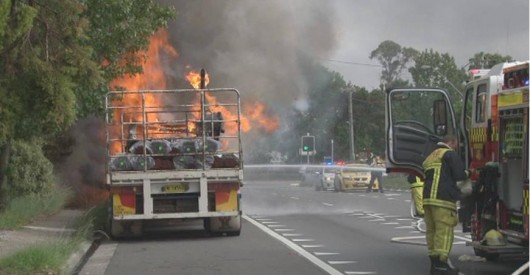 Yet another Dangerous Trucking Menace along the Great Western Highway – last week Yet another Dangerous Trucking Menace along the Great Western Highway – last week
[Source: ‘Firies save “catastrophic” incident after truck catches fire at Faulconbridge’, 20130222, Blue Mountains Gazette, Photo: Top Notch Video
^http://www.bluemountainsgazette.com.au/story/1320007/firies-save-catastrophic-incident-after-truck-catches-fire-at-faulconbrige/]
.
The Dangerous Trucking Menace is becoming increasingly prevalent across the Blue Mountains on both the Great Western Highway and the Bells Line of Road.
This is because the ‘Roads and Traffic Authority‘ – rebranded but culturally unchanged to the ‘Transport Roads and Maritime Services‘ is tasked to re-engineer the Great Western Highway, a regional and local road, to facilitate more trucks.
The trucking mandate is to transform the highway into an expressway designed for bigger and faster trucks, just like the F3 Motorway between outer Sydney and the regional city of Newcastle, as infamously deadly that the F3 is.
The trucking mandate is national and driven by an Australia-wide freight transport policy which prioritises 95% road and 5% rail. The truck-centric policy is steered by self-interested influential trucking magnates and their industry, whose driving catch-phrase is ‘time is money‘ and so any community along the highway that slows their trucks down must be dealt with. They fund political economic rationalism which prefers to outsource and privatise instead of responsibly investing in national rail freight infrastructure.
Highway communities are treated as second class citizens. Residents like the many thousands across the Blue Mountains are increasing exposed to the Dangerous Trucking Menace, when sharing the highway and from their homes:
- Bigger trucks and more B-Doubles
- Speeding trucks
- Tailgating trucks
- Trucks over the centre double lines
- Truck drivers frequently seen talking on a mobile phone while driving
- Exhaust brakes used at all hours through towns and villages
- Collisions and deaths
- Overturned trucks
- Broken down trucks
- Trucks on fire
- Truck tankers with gas, fuel or hazardous chemical leaks
- Selfish truckies sleeping outside residents at all hours with refrigerator motors running at Mt Victoria
- Same selfish truckies found urinating and defecating in residents’ front verges at Mt Victoria.
.
[Ed: And truckies and their supporting wives wonder why truckies have a bad reputation and often cop blame? Trucking is not a profession. It is a uncontrolled cowboy skill-easy job earning pittance, attracting imbeciles and causing reckless maiming and death. This Editor has continued to hold an ‘HC’ licence from 1989, but income-wise has long since moved on.]
.
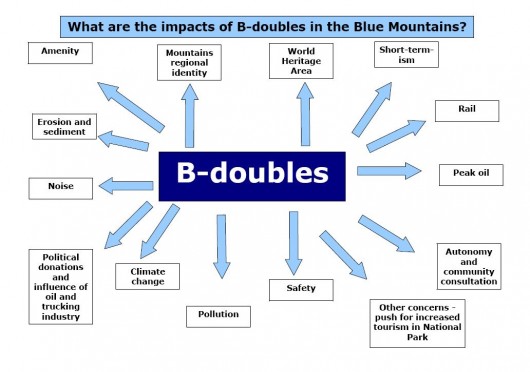 Source: Blackheath Highway Action Group
‘The Blackheath Highway Action group was formed in 2008 to fight a proposal to turn the Great Western Highway
into a 4 lane high productivity freight vehicle (25/26/30m B-doubles) route across the Blue Mountains.
Website: ^http://www.bag.asn.au Source: Blackheath Highway Action Group
‘The Blackheath Highway Action group was formed in 2008 to fight a proposal to turn the Great Western Highway
into a 4 lane high productivity freight vehicle (25/26/30m B-doubles) route across the Blue Mountains.
Website: ^http://www.bag.asn.au
.
Hardly a week passes without some report of a truck-related incident along the Great Western Highway and especially along the Hume Freeway, F3 Motorway and Pacific Highway, and that is just in New South Wales. One local resident of the Blue Mountains, a Marcus Padley, terms these ‘Mack Truck Moments‘. If only it were funny. Last month Sarina Heta in her Kia Rio sedan wasn’t laughing when she was violently crushed between two B-doubles on the Great Western highway at Blackheath.
Australia has no central register of truck incidents, but if it did one wagers that the occurrence would be a daily one. This is unacceptable yet the trucking menace is encouraged and poorly controlled or policed.
Currently, the Great Western Highway is being widened to four lanes at Hazelbrook at great expense and considerable delay due to poor due diligence and mismanagement. In the re-engineered design, all interests of trucks are priorities by the road engineers, while local residents have little or no say. As each stage of widening transformation takes place, successive affected communities become disheartened and confronted by the bulldozing of the regional highway and its replacement with a much wider trucking expressway.
Lawson has been completely obliterated and its character ‘lobotomised‘ as a town.
.
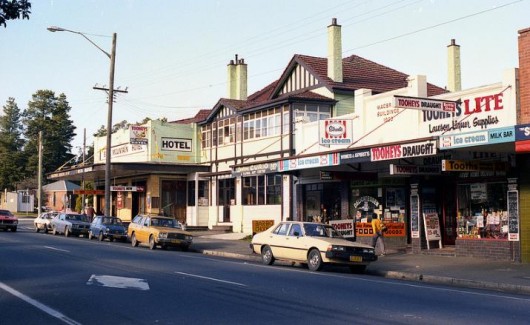 Lawson Lawson
before the Trucking Expressway bulldozers
.
 Neo-Lawson
Shops bulldozed
Village Character urban lobotomised Neo-Lawson
Shops bulldozed
Village Character urban lobotomised
.
Soon it will be neighbouring Bullaburra’s turn and highway properties are already up for sale.
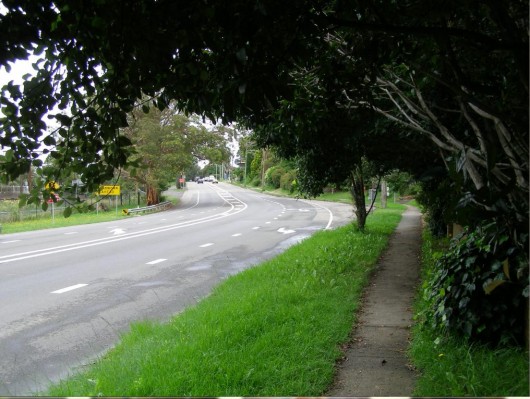 Bullaburra: On Trucking Death Row Bullaburra: On Trucking Death Row
.
The Bells Line of Road across the Blue Mountains is also having its side shoulders widened to accommodate B-double trucks 24/7 and is involving the destruction of native vegetation for kilometres. Stage 1 is around the agricultural village of Bilpin.
Many sand and gravel B-Double style trucks use the Bells Line of Road between quarries and Sydney. They are paid a trip rate and so travel at excessive speed to maximise trips per day. The road has no speed cameras and is rarely patrolled by police. It has become an infamous trucking cowboy route. In June 2012, a sand loaded semi-trailer collided with two cars near Mt Tomah. The truck was probably over the centre double lines like they usually are.
 Semi-trailer cowboy carrying sand and speeding, 4km west of Mount Tomah, June 2012 Semi-trailer cowboy carrying sand and speeding, 4km west of Mount Tomah, June 2012
It rolled, spilling its load across the Bells Line of Road
[Source: ^http://www.cowracommunitynews.com/viewnews.php?newsid=834&id=3]
In May 2011, a gravel truck overturned on the Bells Line of Road while exceeding the speed limit. The road is a renowned trucking menace and car drivers and motorbike riders use it at their own risk. In July 2009, a motorcyclist has been killed on the Bells Line of Road 10 kilometres west of the Mount Tomah. It must have surely been a ‘Mack Truck Moment‘.
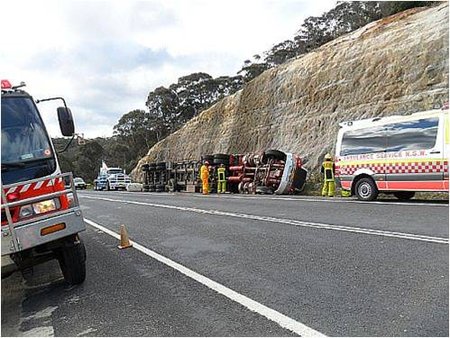 B-Double Rollover on the Bells Line of Road (Nov 2010)
“West Sector Brigades are frequently called to accidents on the Bells Line of Road and Darling Causeway”.
[Source: Rural Fire Service, ^http://www.bluemountains.rfs.nsw.gov.au/dsp_content.cfm?cat_id=129643] B-Double Rollover on the Bells Line of Road (Nov 2010)
“West Sector Brigades are frequently called to accidents on the Bells Line of Road and Darling Causeway”.
[Source: Rural Fire Service, ^http://www.bluemountains.rfs.nsw.gov.au/dsp_content.cfm?cat_id=129643]
.
The government’s Trucking Expressway Mandate is to keep widening the Great Western Highway out to mainly four lanes between outer Sydney where the 6-lane M4 Motorway currently links to, and all the way out to Orange and beyond. The long-term trucking strategy to eventually encourage 24/7 trucking of B-doubles between Sydney and Perth and Darwin. In western Victoria even B-triples have been introduced, which are basically Road Trains – give the trucking lobby time.
B-doubles have to date been prohibited from the Great Western Highway due to its narrow unsuitable design and to respect the fact that it passes through nearly two dozen regional town and villages. But that is constantly being challenged and undermined by hard-nosed government policy.
The dangerous misguided premise by the policy and by road engineers is that a wider a faster trucking expressway will be safer than the existing highway, yet the evidence refutes that. All one needs to do is consider the repeated statistical record of trucks incidents along the already widened sections of the Great Western highway, and indeed along the RTA/RMS’s favourite creation, its F3 Motorway.
The following recent reports of trucking incidents are testament to the trucking menace that trucking expressways attract.
.
2nd March 2013: ‘Overturned Truck Closes F3 at Mount White’
.
<<Mount White: The F3 remains closed northbound approaching the Old Pacific Highway Overpass in Mount White due to a truck accident. Motorists are being diverted off the F3 onto the Old Pacific Highway at the Hawkesbury Interchange in Mooney Mooney. Emergency services and RMS crews are on site, working to clear the accident as quickly as possible…>
.
[Source: ^http://www.facebook.com/livetrafficnsw/posts/451301384941574]
.
27 Feb 2013: ‘Lanes reopen on F3 after gas leak’
.
<<All southbound and northbound lanes have reopened on the F3 near Motorway Link Road in Warnervale now that gas bottles are no longer leaking on the back of a truck. Gas cylinders began leaking on the back of a truck near Motorway Link Road about 6.45pm, forcing the closure of southbound lanes and one northbound lane.>>
.
[Source: ‘Lanes reopen on F3 after gas leak’, 20130227, by Sam Rigney, The Newcastle Herald, ^http://www.theherald.com.au/story/1330772/lanes-reopen-on-f3-after-gas-leak/?cs=305]
.
20 Feb 2013: ‘F3 Truck Fire’
.
<<There was a lucky escape for a truck driver on the Central Coast yesterday. Just after 11am, a Rutherford-bound semi trailer full of clay caught fire, forcing the closure of northbound lanes of the F3 Freeway at Mount White. The driver, from Victoria, had pulled the rig over after seeing smoke billowing from the engine. He escaped unharmed but the same couldn’t be said for the prime mover.>>
.
[Source: ‘F3 Truck Fire’, 20130220, ^http://www.nbnnews.com.au/index.php/2013/02/20/f3-truck-fire-2/]
.
7 Feb 2013: ‘Hume Highway traffic affected after truck roll over’
.
<<Both northbound lanes of the Hume Highway were closed south of Tarcutta following the accident but one northbound lane was since been re-opened. The accident about 15km south of Tarcutta occurred shortly after 9am this morning. Emergency services are in attendance and a HAZMAT team has been sent following reports of diesel over the road. Motorists are advised to drive with caution if in the area and to allow for extra time on their journey.>>
.
[Source: ‘Hume Highway traffic affected after truck roll over’, 20130207, ^ http://www.dailyadvertiser.com.au/story/1285399/hume-highway-traffic-affected-after-truck-roll-over/]
.
Nov 2012: ‘Traffic slow at Ourimbah following truck rollover’
.
<<Traffic is slowing on the F3 Freeway near Ourimbah on the Central Coast where a semi-trailer rolled onto its side about 9.30am. It is understood the driver was trapped for a short time but has since been freed and police are on-site managing the clean up and traffic control.>>
.
[Source: ‘Traffic slow at Ourimbah following truck rollover’, 20121108, by Gabriel Wingate-Pearse, The Newcastle Herald, ^http://www.theherald.com.au/story/786786/traffic-slow-at-ourimbah-following-truck-rollover/]
.
Mar 2012: ‘Police target second trucking firm over safety’
.
<<New South Wales police are targeting another truck company over suspected serious safety breaches. Trucks from the South Australian-based Scott’s transport are being stopped at several heavy vehicle checking stations, including the F3 freeway at Mount White and the Hume Highway at Marulan. Officials from Roads and Maritime Services are also involved in the operation.
Police say one of the company’s B-double trucks was caught driving on the Hume Highway at Mittagong at 142 kilometres per hour early on Monday morning. Officers are searching for 32 Scott’s trucks out of the company’s fleet of more than 300, and say that number may rise. They say the trucks will then undergo a comprehensive mechanical inspection. The investigation follows an operation against Sydney-based Lennons Transport Services, where police say speed limiting devices in numerous trucks had been tampered with.
A Lennons driver is before the courts charged over a crash that killed three people on the Hume Highway at Menangle in January.>>
.
[Source: ‘Police target second trucking firm over safety’, 20120308, ABC News, ^http://www.abc.net.au/news/2012-03-07/police-target-second-trucking-firm-over-safety/3874324]
.
Jul 2011: ‘Delays on freeway after truck rollover’
.
<<NSW motorists on the F3 freeway are being warned to expect significant delays after a B-double truck rolled over at Cooranbong southwest of Newcastle. The truck, which was carrying milk, rolled onto its side and skidded for several metres at the Freemans Drive overpass before being hit by a ute.
The truck driver was taken to hospital but the woman driving the ute escaped injury. A salvage operation is underway but it is expected the freeway will be blocked for several hours. Southbound traffic is being diverted at Palmers Drive to re-enter at Freemans Drive southbound on-ramp.>>
.
[Source: ‘Delays on freeway after truck rollover’, 20110713, AAP, ^http://www.heraldsun.com.au/news/breaking-news/delays-on-freeway-after-truck-rollover/story-e6frf7jx-1226093503064]
.
Aug 2010: ‘Heavy metal horror as deaths soar’
.
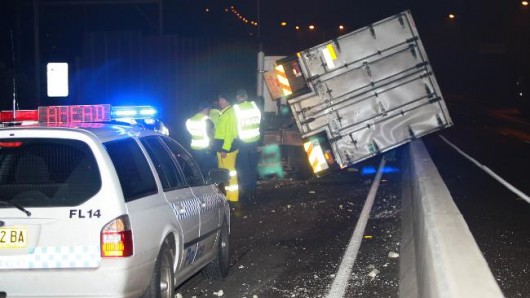 Lost load … the scene at Chullora where a refrigerated pantech fell from a truck
[Source: Picture: Bill Hearne, The Daily Telegraph] Lost load … the scene at Chullora where a refrigerated pantech fell from a truck
[Source: Picture: Bill Hearne, The Daily Telegraph]
.
<<It was a year of carnage for the state’s truck drivers, with the number of fatal accidents increasing by more than 90 per cent, government statistics reveal.
There were 23 fatal crashes involving heavy rigid trucks – non-articulated vehicles greater than eight tonnes – in 2009. This was up from 12 a year earlier, the Bureau of Infrastructure, Transport and Regional Economics (BITRE) said. The BITRE data also showed the number of people killed in accidents involving heavy rigid trucks in NSW was up 100 per cent to 24, when deaths in Australia decreased by 14.7 per cent.
The RTA dismissed claims that the increase in the road death statistics were a cause for concern. The RTA’s NSW Centre for Road Safety director Soames Job said the increase was the result of a reduction in deaths the year before. “The main number that produces the outcome is the low number of deaths the previous year. It was extraordinary that we had so few in 2008,” Dr Job said.
Fatal accidents involving articulated trucks fell from 47 in 2008 to 34 in 2009, BITRE said. The figures came as a truck driver had a lucky escape in Sydney’s west on Tuesday night.
The refrigerated section of a meat carrier sheared from the truck and rolled on to the Hume Highway flyover at Chullora. A crane was brought in to right the truck to clear the road.
Dr Job said in many crashes, the smaller vehicle might be at fault. “Lots of these accidents will involve speed and fatigue and that is what we are trying to address,” he said. “We have this large program of speed enforcement in areas where there is known heavy truck traffic and that is why we have said we’ll roll out 20 locations of point-to-point speed cameras across our highway network”..>>
.
[Source: ‘Heavy metal horror as deaths soar’, 20100812, by Rhys Haynes, The Daily Telegraph, ^http://www.dailytelegraph.com.au/news/sydney-news/heavy-metal-horror-as-deaths-soar/story-e6freuzi-1225904114783]
.
Aug 2010: ‘B-double crashes on F3, shutting southbound lanes’
.
<<Motorists using the F3 Freeway are being told to divert their travel or face significant traffic delays after a B-double carrying gas cylinders crashed today. The truck was carrying 1600 nine kilogram cylinders when it hit the eastern brick wall just before the Hawkesbury River Bridge about 9:15am.
No one was injured but the crash forced police to close two of the three southbound lanes. Northbound lanes remain open and all lanes are expected to be opened by 4pm. Southbound motorists are being urged to avoid the area by taking the Pacific Highway exit at Brooklyn,” a police statement says. “The gas cylinders are being removed by hand for safety reasons prior to the B-double being removed. Inquiries into the crash are continuing.>>
.
[Source: ‘B-double crashes on F3, shutting southbound lanes’, 20100831, ^http://www.fullyloaded.com.au/…]
.
Jun 2010: ‘Driver dies after flipping truck on F3’
.
<<A man has died in a truck accident on the F3 at Mount White on the New South Wales central coast yesterday. Police say the driver was turning into a heavy vehicle checking station when his trailer jackknifed at about 3:30pm. The truck then flipped onto the driver’s side before sliding into a power pole. The male driver, who has not been formally identified, was killed. A report will be prepared for the Coroner.>>
.
[Source: ‘Driver dies after flipping truck on F3’, 20100614, ABC News, ^http://www.abc.net.au/news/2010-06-14/driver-dies-after-flipping-truck-on-f3/865866]
.
Apr 2010: ‘Highway smash raises response time questions’
.
<<The New South Wales Roads Minister says the RTA did not act quickly enough to re-open the F3 Freeway after an accident south of Newcastle yesterday, which left motorists stranded for hours.
A flat-bed truck ran into the back of a fully loaded fuel tanker on the freeway around midday near Mount White, with the accident closing all northbound lanes.
The RTA set up a contraflow around the accident site, using southbound lanes for motorists heading north, and diverting southbound traffic along the old Pacific Highway.
Questions are being asked why it took so long to set up the contraflow, which was not in place until at least eight hours after the crash.
Hazmat crews worked to remove fuel from the tanker, with the Fire Brigade declaring the area safe sometime around midnight.
The Roads and Transport Minister David Campbell says he will be meeting with the RTA today to discuss the delay in re-opening the road.>>
.
[Source: ‘Highway smash raises response time questions’, 20100413, ^http://www.abc.net.au/news/2010-04-13/highway-smash-raises-response-time-questions/2588890]
.
Apr 2010: ‘F3 still closed after tanker crash’
.
<<The northbound lanes of the F3 freeway north of Sydney could remain closed for up to six hours this evening after a truck accident.
A truck crashed into the back of a fuel tanker at Mount White and traffic is being diverted via the Old Pacific Highway.
The man driving the truck was taken to hospital with serious head injuries.
NSW Fire Brigade controller Ian Krimmer says it could take some time before the fuel is transferred from the tanker and the freeway is re-opened.
“Not good news at all unfortunately. We’re in the hands of the transport company that is trying on scene to conduct the pumping process,” he said.
“When it arrives on scene we have to remember there’s some 43,000 litres of fuel before we can remove the tanker from the road.
“That process could take four to six hours.”>>
.
[Source: ‘F3 still closed after tanker crash’, ABC News, 20100412, ^http://www.abc.net.au/news/2010-04-12/f3-still-closed-after-tanker-crash/2599556]
.
Apr 2010: ‘Major delays after F3 truck crash’
.
<<A truck driver has been left with serious head injuries after an accident on the New South Wales central coast. Police say the accident happened on the F3 Freeway at Mount White at about 11:40am (AEST). It is believed a flat-bed vegetable truck ran into the back of a fully laden petrol tanker…>>
.
[Source: ‘Major delays after F3 truck crash’, 20100412, ABC News, ^http://www.abc.net.au/news/2010-04-12/major-delays-after-f3-truck-crash/2596044]
.
Sep 2009: ‘Delays on Sydney’s F3 after another fatality’
.
<<Traffic is being delayed on the F3 freeway as police investigate a death near the Mooney Mooney Bridge, south of Gosford. Police say a man fell onto the road and died just after 1pm AEST. All northbound lanes have been closed while investigations are carried out…>>
.
[Source: ‘Delays on Sydney’s F3 after another fatality’, 20090903, ABC News, ^http://www.abc.net.au/news/2009-09-03/delays-on-sydneys-f3-after-another-fatality/1415962]
.
Aug 2009: ‘Young parents and baby die in F3 inferno’
.
 The wreckage on the F3 after the fatal crash
A couple and baby killed
[Photo: Matt Black Productions] The wreckage on the F3 after the fatal crash
A couple and baby killed
[Photo: Matt Black Productions]
.
<<A young Gosford couple and their baby were killed when their car burst into flames in a crash involving a B-double truck and another car on the F3 freeway on the NSW Central Coast yesterday night.
Police said two cars stopped on the freeway before a truck struck both vehicles from behind, killing a 27-year-old woman, a 32-year-old man and a five-month-old baby at 10.50pm. The impact caused one of the cars and the truck to catch fire. There was also another triple fatality in central-northern NSW about 10.30am today on Newell Highway near Narrabri.
Police said the bodies of the young family were found in the charred car on the 110 km/h marked stretch of road near the Mount White weigh-bridge. Two other people were taken to Gosford Hospital with various injuries.
Metropolitan crash investigator Sergeant Peter Jenkins said the family’s car was completely “incinerated”. “For some reason the two vehicles have become stationary in lane one, northbound, they’re not in the breakdown lane, they’re actually still in the traffic lane,” he told Macquarie Radio today.
“The young family’s car is the southern vehicle, another northbound car has braked and stopped and swerved to miss it and entered into the breakdown lane.
“Since that’s happened the truck driver’s been exposed to these two vehicles and he’s done what he can, but he hasn’t been able to avoid these two vehicles.” He said the truck driver was suffering from shock and had been discharged from hospital after speaking to police.
Towers Transport general manager John Perkins said the truck driver was very upset. “He has no apparent physical injuries … he’s extremely distraught,” Mr Perkins said.
He would not comment on the circumstances surrounding the accident but said the company had never been involved in a fatal crash. “We’ve been in business for 20 years, we’ve got about 50 trucks, and this is the first time we’ve been faced with something like this,” Mr Perkins said.
The driver of the second car was taken to Gosford Hospital for treatment, but police have been unable to to speak to him. His condition is unknown. The family has been identified and some relatives have been notified of their deaths, he said.
Sergeant Jenkins played down claims the stretch of road was dangerous, saying he hadn’t been able to attribute a serious crash in the area to the design or condition of the road in the past 20 years.
“I think the F3 is actually quite a good stretch of road in most parts,” he said.
“Inquiries into the circumstances leading up to the crash are continuing,” a police spokesman said.
‘Expect long delays’
Northbound lanes on the F3 freeway out of Sydney have reopened to traffic but motorists are warned to expect long delays.
All northbound lanes were closed while police removed the bodies and wreckage and carried out an investigation until about 11.20am today.
Despite reopening the lanes, traffic is still banked up for almost 10 kilometres between Mount White and the Hawkesbury River, the Road and Traffic Authority says.
“All lanes are open on the F3, but traffic will take a while to clear, an RTA spokesman told AAP.
“Traffic is still heavy with significant delays and people who have been diverted on to the Pacific Highway will also experience significant delays.”
It is the second major crash in two days on the F3 in that area. Four people escaped serious injury in a six-vehicle crash caused when a piece of scaffolding fell off a semitrailer at Mooney Mooney yesterday.
Police are appealing for anyone who might have seen the crash and are yet to speak to crash investigators to contact them via Crime Stoppers on 1800 333 000.>>
.
[Source: ‘Young parents and baby die in F3 inferno’, 20090828, by Georgina Robinson, Dylan Welch and AAP, ^http://www.smh.com.au/national/young-parents-and-baby-die-in-f3-inferno-20090828-f1fe.html]
.
SELECTED COMMENTS TO THIS INCIDENT:
.
Maxamillion:
<<Car drivers have had lots of restrictions placed on them over the years in an attempt to reduce the road toll including school zones due to a slight increase in accidents. A 100% increase in heavy truck deaths is not acceptable. Reduce their speeds to 60kph and reduce fatigue by reducing driving time to 6 hours per day and accidents due to speed or fatigue will drop. Imagine what would happen if car deaths increased 100%. Would we see changes, you can bet on it.>>
.
Rod Pickin:
<<Until the maximum road speed for heavy vehicles is limited to 80kph, you can expect a continued increase in accidents/deaths involving these vehicles. Currently heavy vehicles are being driven dangerously and at high speed as a result of work/deadline pressures imposed upon drivers by owners/operators and major supermarket customers all sanctioned by govt. bodies.
Truly how rediculous is it that a fully loaded B-Double even road train fuel/gas tanker is legally allowed on our highways in the wet to travel at 100kph? that is just inviting major drama so one is entitled to ask, who is putting presure on who in order that this be allowed.>
.
Rob:
<<I’ve noticed the lack of ‘100 speed limited’ signs on most trucks these days as they go flying past me on the highways while I’m obeying the limit.>>
.
Julian:
<<This is sad. The carnage on the F3 goes on, mostly involving semi-trailers. When I take my family on holidays, trucks tail-gate us at 120Kph, and scare the hell out of me.>>
.
Young parents and toddler die in fiery crash:
<<The solution is simple. make speed limit for trucks 70kmh max and must not move out of left lane for whatever reason. the F3 is the most dangerous freeway I have ever driven on, doing 100-110 on blind hills and bends a truck has no way of stopping fast if it has to.>>
.
David:
<<I drive the F3 every day and it is a miracle that more accidents such as these do no occur. In peak hour the average speed of vehicles is in excess of speed limit and cars do this with the knowledge that they are highly unlikely to be caught. When police do drive along the freeway they also average around 10 kph above the speed limit and cars just happily follow them at that speed.
In the road works area you have speed variances of between 80 kph (speed limit) and 120 kph with average of around 100 kph. To sit on the speed limit along that road is nearly more dangerous than speeding. This is a tragedy as are all road deaths and one can only hope that this does force the authorities into action so that something positive comes from it to get some sanity back into the way drivers behave on this road.>>
.
mirage:
<<I’m sure its another example of a truck driver that was speeding – I travel every few weeks up and down the F3 in a normal sedan at 100-110km per hour and most trucks fly past me except when going up the hills…the Police are not doing enough and some truck drivers just think they can do what they want…same attitude problem as the ferry drivers on the harbour and bus drivers…they think the road is theirs and they are smarter than the rest, professional drivers…they should know that in the end the extra speed doesnt make much difference…>>
.
More Trains, Less Trucks:
<<One partial solution would be to build a freight line so that we could send more goods by rail. Think about howmany trucks would be off the road for each extra train. I am sure that the truckies would complain about potential loss of jobs, but that wasn’t the case when the Ghan was extended from Alice Springs to Darwin.
Instead of losing jobs, the truckies found that they had more short haul jobs supplying the freight trains and less long haul jobs with all of the associated safety issues.>>
.
Kate:
<<I used to drive the F3 regularly but now catch the train as it is too dangerous. If you look at the accident record over the past few years, you will see most involve trucks. The F3 is one of the few decent roads in the state, yet now ruined by huge speeding semis and other trucks that are a terrible hazard to cars. On top of that everyone speeds like the devil, with impunity it seems. All those massive tonnes of heavy goods in transit should be shipped by rail. The whole transport thing is getting completely out of hand.>>
.
frederick:
<<I am often horrified at the increase in trucks on our roads and the frequent aggressive driving adopted by these drivers. Driving generally on our roads has become so bad that this sort of horror is going to keep happening. Anyone who drives at or near the speed limit would know. Unless of course our pollies have the guts to do something about it and the Police start to enforce some of the existing road rules. With three warning signs before every fixed speed camera we might as well adopt a new slogan for NSW – THE DUMB STATE!
How many more lives is it going to take before we come to our senses?>>
.
Ian C. Purdie:
<<Yes, so trucks are speed limited to 100 kph, the sign on the back says so. That would be the reason they either tail gate you at 110 kph or overtake.>>
.
waqi13:
<<I travel on F3 several times each week for work. At least once a week I have a close call with truck drivers not paying attention to what is going on around them. It seems that 90% of trucks have blinkers and side mirrors that don’t work – they change lanes at the drop of a hat with no indication, and in the worst case scenario to overtake another truck that they cannot go fasther than anyway – creating a long line of traffic, chugging up a hill at much less then the speed limit.
I have learnt to give trucks a wide berth, because they will do what they want to do without checking for any cars around them.>>
.
Daniel:
<<It’s a dangerous road at night and drivers need to have full concentration on the freeway. they need to stick to the speed limit. Ive driven on it so many times and I do 110 and others are flying past me all the time. Trucks are going faster than the 100 they are supposed to be doing. Most of the time now I use the old Pacific Highway through to Gosford. its just too dangerous with all the rats on the road.>>
.
JSKS:
<<It’s very sad indeed. In fact 110km/hr is a very fast speed for a fully loaded truck. It’s not easy for the truck to stop that easily when their loads are full. At 10.30pm, the truck light shining distance is at best 30 meters. I believed by the time the driver realised that there is a car in front, it’s too late to stop effectively. In other countries, while the Freeway limit is 110km/hr, the maximum speed limit for truck is only 90km/hr. Yes, this will delay delivery time but I think HUMAN LIFE is more important than delivery time.>
.
SP233K:
<<I drive on the F3 every day, and seriously no one obeys speed limits,they tailgate,they speed like crazy,the have no regard for anyone else,trucks speed and change lanes cutting people off and don’t care at all. Every day i worry i will end up in an accident and as soon as it gets dark trucks drive about a thousand times worse,they would have no way of stopping quickly.
Police constantly pull over cars (in the event there are actually police patrolling which is not very often). I really think they should be pulling over trucks as well. I hope this is a warning to everyone to be more careful on the F3, surely there have been enough horrific accidents for everyone to see how dangerous it is.
My heart goes out to the families of the people involved in last night’s accident. I drove past this morning and it really was a horrible scene.>>
.
[Sources: ‘Surviving driver may hold F3 horror key to why young family stopped on freeway’, 20090829, by Rhys Haynes, Justin Vallejo, The Daily Telegraph, ^http://www.dailytelegraph.com.au/news/surviving-driver-may-hold-f3-horror-key-to-why-young-family-stopped-on-freeway/story-e6freuy9-1225767218559: and ‘Young parents and baby die in F3 inferno’, 20090828, Sydney Morning Herald, ^http://www.smh.com.au/national/young-parents-and-baby-die-in-f3-inferno-20090828-f1fe.html]
.
May 2009: ‘B-double involved in F3 collision with car’
.
<<There has been yet another traffic accident on the F3 involving a B-double truck, overnight. About 10.40pm last night (Tuesday), the driver of the B-double truck, a 38-year-old man from Cundletown, allegedly changed lanes and ran straight into a car being driven by a 63-year-old man from Umina. Both vehicles were travelling north along the freeway at Wahroonga, near Alexandria Pde.
When the car was hit, it spun out of control, police said, and collided with the median guardrail. The driver of the car was trapped until emergency crews cut him from the wreckage.
He was taken to the Royal North Shore Hospital with suspected back injuries and remains in a serious but stable condition. Hornsby Police have told the Advocate they will wait on the results of blood test before taking any action. No charges have yet been laid.>>
.
[Source: ‘B-double involved in F3 collision with car’, 20090527, Hornsby Advocate, ^http://hornsby-advocate.whereilive.com.au/news/story/another-b-double-involved-in-f3-collision-with-car/]
.
Apr 2009: ‘F3 truck ‘cut off’ before cliff plunge’
.
<<Police are searching for the driver of a white Kenworth truck seen close to a semitrailer that plunged 80 metres off the F3, north of Sydney yesterday. Emergency services workers have recovered the body of the 40-year-old driver. The driver is reported to have been married with a young child.
The semitrailer will be salvaged by crane from 8pm today, with northbound traffic to be diverted from the F3 at Wahroonga. The B-Double Linfox semitrailer was carrying toilet paper when it crashed through a safety barrier at the side of the freeway and fell into the valley near Hornsby about 11.35am yesterday.
Two northbound lanes of the F3 were closed and traffic was diverted after the crash. Police are investigating reports the Sydney man had swerved to miss another truck which had changed lanes in front of him, before his vehicle speared off the road. Police today appealed for the driver of the Kenworth truck to come forward.
“We are appealing for the driver of a white Kenworth that was close to the [semitrailer] at the time of the crash to contact police through the Crime Stoppers hotline and tell us what they know or what they might have seen at the time the truck went over the railing,” a NSW Police spokeswoman said.
Senior Sergeant Peter Jenkins of the Metropolitan Crash Investigation Unit said witnesses told police there were some trucks near the semitrailer before the crash happened.
“It would apply at this stage that they might not have contributed to the crash. They might be totally innocent people driving along. But we would like to interview them because they may know something about the reason why this gentleman has left the roadway,” he said. “So we are appealing to them as witnesses at this stage.”
Senior Sergeant Jenkins said it was raining quite heavily when the accident occurred and police would be investigating all the possible accident factors, including weather, road surface, traffic, mechancial issues and the driver’s schedule.
But Phil Easterbrook, who lives near where the accident happened and heard a bang, said the accident was not unexpected. “We always hear the sound of horns going off and of braking. They are [hooting] to avert an accident because people are cutting them off,” he said. “We hear banging quite regularly from vehicles from accidents happening.”
Mr Easterbrook, who used to drive a truck, said trucks would try to build up speed as they went up the hill, and so would not like other vehicles cutting them off.
.
ROAD SURFACE HAZARD
Paul Gerrard, who uses the F3 daily to travel from Kellyville to his work in Tuggerah and back, said the road surface where the accident occurred had been a serious hazard for a few months.
“Approximately four to five months ago the original freeway road surface [bitumen] was removed by mechanical pavement machines in an overnight operation that went for several weeks,” he said. “In the absence of signs it appears the pavement was removed to enable the whole freeway to be resurfaced with bitumen after the widening project [of the freeway] is completed.
Mr Gerrard said the northbound lanes, which were resurfaced, now had a rough texture and were dangerous to drive on especially during heavy rain. “The road gets far too much water and there’s no control. My experience is that, during heavy rain, drivers must slow to approximately 70kmh or the car aquaplanes left. It is an expectation and not random.”
He said the rails along these lanes were dented from large impacts of vehicles hitting them.
An RTA spokesman said that, while it could not comment on the accident as it was the subject of a police investigation, concrete roads such as the ones on the F3 were not uncommon in NSW.
“The RTA regularly carries out tests on road surface across the state and this section of road was last tested in August and September of last year. These tests showed that the road surface provided adequate wet-weather grip,” the spokesman said. The RTA spokesman said it understood the accident took place “on a downhill section where surface water would not accumulate”, and advised motorists to slow down and adjust their driving when there was wet weather.
From 2003 to 2007, there were six crashes reported on the 1km northbound section of of the F3 just north of the Edgeworth David Avenue overpass at Wahroonga, the spokesman said.
None of the crashes involved heavy vehicles and there were no deaths, he said.
.
CRANE FAILED TO MOVE SEMI-TRAILER
A crane was brought in to lift the semitrailer, but a 7?-hour operation from 4.30pm to midnight by emergency services failed to move it.
“The boom on it to go down to the truck was not long enough,” an RTA spokeswoman said. A larger 400-tonne crane would be brought in to lift the truck tonight, the spokeswoman said.
It was not yet decided which company would be supplying the crane, although it was likely Linfox would foot the bill, she said.
The RTA said the crane would take three to four hours to assemble, and the same time to disassemble. It said it would take four hours to move the truck. The RTA will close access to the F3 northbound from the Pacific Highway and Pennant Hills Road at Wahroonga during the salvage operation.
Traffic would rejoin the F3 at Berowa. Diversions were expected to be in place until 8am tomorrow, the RTA said. Southbound lanes would not be affected. Yesterday’s fears that the fuel spilt from the truck would cause environmental damage have also dissipated, NSW Fire Brigades spokesman Craig Brierley said.
The diesel from the truck spread over a large area and sank into the soil beneath the truck, but did not reach the water catchment area nearby, Mr Brierley said. The low amount of fuel in the tank and its cargo meant there were fewer fears about its impact on the environment, he said. “There was only 500 litres of diesel on the truck, which is not a lot, so that made the job a lot easier,” Mr Brierley said. Hazmat crews were at the site of the crash for most of yesterday night and would check the area again when the truck was removed, he said.
.
[Ed: Was the RTA recklessly culpable for the driver’s death?]
.
FUND ESTABLISHED TO HELP FAMILYT OF DEAD TRUCKIE
The young family of the driver will be the recipients of a fund established by transport union officials.
“The man who died yesterday had a young family and what happened can only be described as a tragedy,” Transport Workers’ Union NSW secretary Wayne Forno said today. “The TWU is calling on all members to donate to a fund we are setting up for the man’s family, and Linfox has indicated they will match those donations. “But we are also calling for a full investigation into the incident, and for the coroner to examine how hyper-competitive road freight industry and the inadequate pay and conditions of truck drivers are contributing to more deaths on the road.”
A Linfox spokesman said the company did not comment on donations, but “conditionally we would match what colleagues contribute”.>>
.
[Source: ‘F3 truck ‘cut off’ before cliff plunge’, Sydney Morning Herald, 20090422, by Glenda Kwek, AAP, ^http://www.smh.com.au/national/f3-truck-cut-off-before-cliff-plunge-20090422-aeal.html]
.
.
Oct 2008: ‘Truck catches fire on F3’
.
<<There has heavy traffic on the F3 freeway north of Sydney after a truck caught on fire just before 11:00am AEDT today. The accident blocked all northbound lanes at Mount White, but traffic is now moving slowly after a lane was reopened. It is not yet known what caused the blaze.
Kate Martin was driving on the freeway when the accident happened. “It was on fire, really badly on fire, black smoke just streaming out of the truck,” she said. “It took a while for the police to arrive. It was burning for about 10 minutes before any services arrived.”>>
.
[Source: ‘Truck catches fire on F3’, 20081009, ABC News, ^http://www.abc.net.au/news/2008-10-09/truck-catches-fire-on-f3/536316]
.
Nov 2007: ‘Drivers urged to delay after F3 smash’
.
<<Commuters on the New South Wales Central Coast are being urged to delay their drive to Sydney after a crash involving a semi-trailer and several cars on the F3 freeway, near Mount White.
The Ambulance Service says two women and a teenage girl are in a stable condition in hospital after the accident. Roads and Traffic Authority spokesman Alec Brown says all three southbound lanes are blocked and traffic is backed up for three kilometres.
Mr Brown says it is not known how long it will take to clear the accident. “It’s impossible to predict. It really does depend on how smoothly it goes,” he said. “We’ve removed one truck already. We’re working on the rest of the vehicles and that’s something we’re doing as a priority.”
Traffic is being diverted onto the Old Pacific Highway.>>
.
[Source: ‘Drivers urged to delay after F3 smash’, 20071109, ABC News, ^http://www.abc.net.au/news/2007-11-09/drivers-urged-to-delay-after-f3-smash/720460]
.
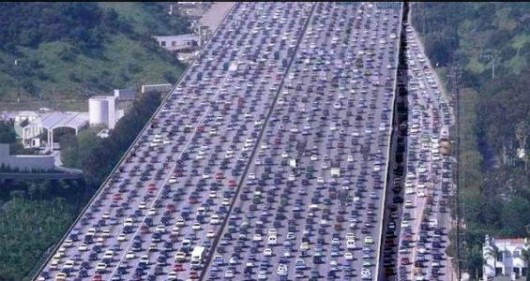 Motorway Widening Cancer
Road Widening is a Chicken and Egg causality dilemma
– widen it and they shall come and then congest it, so widen it again… Motorway Widening Cancer
Road Widening is a Chicken and Egg causality dilemma
– widen it and they shall come and then congest it, so widen it again…
.
<<It doesn’t matter who’s right in this situation. The bigger problem has been the failure of the Australian government for setting unrealistic freight rail goals for Port Botany.
After setting a goal of shipping 40 percent of all Port Botany cargo by rail, the Australian government has dropped its target to 28 percent
“’Forty per cent was unrealistic and unachievable and typified Labor’s propensity to pluck figures out of the air,” the Transport Minister, Gladys Berejiklian, told the Sydney Morning Herald.
The increased number of trucks on the road is already causing considerable delays for motorists. Last Friday, one semi-trailer jack-knifed across one highway, according to the Herald, causing a traffic jam roughly 5 miles long.>>
.
[Source: ‘Sydney traffic worsens as freight forwarding climbs’, 20111128, by Kevin Scarpati, Supply Chain Digital, ^http://www.supplychaindigital.com/global_logistics/sydney-traffic-worsens-as-freight-forwarding-climbs]
Tags: B-double crashes, B-Double Menace, b-doubles, Bells Line of Road, Blackheath Highway Action Group, Blue Mountains, Bullaburra, Dangerous Trucking Menace, dangerous trucks, F3 Motorway, F3 Motorway Truck Crashes, Great Western Highway, Great Western Highway development, Hume Highway, Mack Truck Moments, Mount White, Mt Victoria, Old Lawson, Roads and Traffic Authority, Speeding trucks, Tailgating trucks, Transport Roads and Maritime Services, truck rollover, trucking expressway, Trucks on fire, Trucks over the centre double lines
Posted in Blue Mountains (AU), Threats from Road Making | 2 Comments »
Add this post to Del.icio.us - Digg
Leave a Reply
You must be logged in to post a comment.
February 25th, 2013
 Perth Hills Bushfires at Roleystone, Feb 2011
(Photo credit: AP) Perth Hills Bushfires at Roleystone, Feb 2011
(Photo credit: AP)
.
In our technologically advanced society, many people now wrongly presume that Humanity has elevated itself above Nature and so no longer needs to respect it. This misguided attitude extends to government.
In Australia, people continue to build homes in flood prone river plains, and governments continue to approve them. People continue to build homes in bushfire prone areas that are indefensible from bushfire, yet governments continue to approve their construction.
Almost every year now, a natural disaster hits a community somewhere in Australia.
.
The Once in a Hundred Year Event is a Vernacular Myth
.
So is it community ignorance, memory loss, denial or primeval fatalism? Perhaps it is just plain old foolhardiness – she’ll be right, it won’t happen to me, our technologically advanced society has insulated us from the forces of Nature.
Lives, property and what’s left of native Australia (its flora and fauna) suffer or are devastatingly lost to natural disasters, and also disturbingly to Man-made ones. Unprepared communities suffer, go into shock, and experience trauma. They question and with the self-serving interests of commercial media seek answers, get angry, seek blame, and call on government to explain and learn from its failure to protect them from Nature’s fury. In the case of bushfire disasters, as Australia’s encouraged expanding human population encroaches further into the Australian bush, people have become inherently more susceptible to bushfire risk. So when bushfire tragedy occurs, these people blame government and call for the inevitable ‘enquiry’. Governments react by delivering enquiries.
Since the 1939 Black Friday bushfire catastrophe, Australia has a library full of these post-disaster government enquiries. But are we learning from all these enquiries? Are we better prepared and able to cope with Nature’s fury?
Governments may be getting better at emergency management but the pace appears incremental. At each disaster, government’s emergency management comes under criticism in the ensuing enquiry, which sends a message that government emergency management is always falling well short of community expectations. Then after each enquiry and its report into what, why, how and why not in readiness and response to the natural disasters, what lessons are put into action? History shows repeatedly that short-term memory prevails, government finds a scapegoat, increases the emergency management budget, then getrs distracted on other political priorities of the day; but otherwise reverts to business-as-usual laissez faire. The same policy, systems, people and infrastructrure are left in place, which is most convenient to government, but which most sets the scene for future failure all over again.
Government across Australia, at all its duplicated levels, has a fundamental civic duty to do their utmost to protect citizens from disasters – invasion, storms, floods, bushfires. Given the increasing trend in the scale, severity and frequency of natural disasters and the increased exposure of more people in harms way, governments’ business-as-usual convenience is not good enough..
‘A Geneva based research centre has described 2010 as the deadliest year from natural disasters in two decades – and Australia ranks in the top ten countries affected. The 12th January 2010 earthquake in Haiti devastated the island nation and killed over 222,000 people. Some 373 natural disasters killed over 296,800 people in 2010, affecting nearly 208 million others and costing nearly US$110 billion, according to the Centre for Research on the Epidemiology of Disasters (CRED).’
[Source: ^http://www.probonoaustralia.com.au/news/2011/01/deadliest-year-natural-disasters-2010]
.
Now that these risks are well know and more probable, it is not only not good enough, it is clear that governments have become grossly negligent in its civic duty to properly invest in emergency management. Yet risk is not matched with resourcing. Or is it that Australians are content with taking a fatalistic approach to Nature’s fury? Are Australians content for our governments to continue with their ‘business-as-usual’ political priorities and conveniences, ignoring emergency management?
But Australian values have evolved. Australian society expects emergency management to more than to protect ‘life and property’. Many in our society now place a high value also on livestock, arable land, native forests and native animals. As Australia’s population has increased considerably, these once taken for granted assets of Australia have become scarcer and so more valuable. Whilst human life and property remains of course the highest priority, to ignore these and to lose these in bushfire has become increasingly unacceptable to many Australians. But if these evolved values have not been adopted by government emergency management then there has become a serious disconnect between government priorities and the communities it represents. Public debate on this disconnect is long overdue.
In Australia and in our region it’s now become ‘another season, another natural disaster’. Tragically, in just the past four years, Australians have witnessed Nature’s fury and government failure in emergency management to protect and mitigate the loss of what we value:
.
- 2009 SE Australia 3-week heatwave
- 2009 Victoria’s Black Saturday bushfires
- 2009 Perth bushfires at Badgingarra and Toodyay
- 2009 Boorabin NP bushfire (WA)
- 2009 Samoa earthquake and tsunami
- 2009 Severe hails storms across NSW & ACT
- 2010 Severe storm hits Perth
- 2010 Severe storm hits Melbourne
- 2010 Cyclone Yasi in Far North Queensland
- 2010 Queensland Floods
- 2011 Christchurch Earthquakes
- 2011 Perth Hills bushfires
- 2011 Japanese earthquake and tsunami
- 2011 Ash cloud grounds many Australian flights
- 2011 Floods in northern NSW and Wollongong
- 2011 Severe storm hits Perth
- 2011 Floods in central Victoria
- 2011 Queensland Floods -Lockyer Valley, Brisbane River, Rockhampton, etc
- 2012 Queensland Floods
- 2012 Cyclone Lua in WA Pilbara
- 2012 Cyclone Iggy along WA coast
- 2012 Cyclone Heidi in WA Pilbara
- 2012 Port Lincoln Bushfire in South Australia
- 2012 Bushfire in the Gascoyne, WA
- 2012 Storms across SE Queensland
- 2013 Tasmanian Bushfires
- 2013 NSW Bushfires
- 2013 Victorian Bushfires
- 2013 Western Australia Bushfires
- 2013 Eastern Australia Floods
.
This list is not exhaustive and we are not yet through 2013.
.
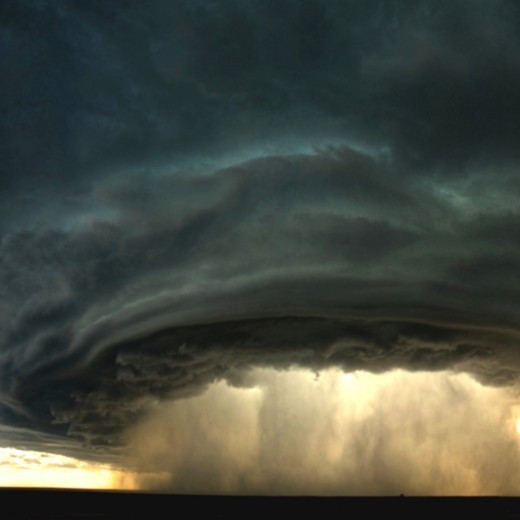 . .
Leave a Reply
You must be logged in to post a comment.
|
|
 The trunk of a healthy 300+ year old Angophora lies beside the highway in Bullaburra
Blue Mountains, New South Wales, Australia
[Photo by our investigator, 20130403, Photo © ^Creative Commons]
The trunk of a healthy 300+ year old Angophora lies beside the highway in Bullaburra
Blue Mountains, New South Wales, Australia
[Photo by our investigator, 20130403, Photo © ^Creative Commons]
 Witnessing an old friend being slaughtered
[Photo by our investigator, 20130403, Photo © ^Creative Commons]
Witnessing an old friend being slaughtered
[Photo by our investigator, 20130403, Photo © ^Creative Commons]
 We tried to save you
Campaign to Save Bullaburra’s 300 year old Angophora back in 2008
(Blue Mountains Gazette, 20081203)
We tried to save you
Campaign to Save Bullaburra’s 300 year old Angophora back in 2008
(Blue Mountains Gazette, 20081203)
 Tree of Knowledge, Barcaldine, Queensland
As it used to be, before it was poisioned.
[Source: Queensland Historical Atlas, 1991,
^http://www.qhatlas.com.au/photograph/tree-knowledge-barcaldine-1991]
Tree of Knowledge, Barcaldine, Queensland
As it used to be, before it was poisioned.
[Source: Queensland Historical Atlas, 1991,
^http://www.qhatlas.com.au/photograph/tree-knowledge-barcaldine-1991]
 A dendrochronology of more than 300 annual growth rings.
The tree was healthy to the core. It was not rotting. It was not diseased.
It was just in the way of someone’s trucking interpretation of ‘progress’.
[Photo by our investigator, 20130403, Photo © ^Creative Commons]
A dendrochronology of more than 300 annual growth rings.
The tree was healthy to the core. It was not rotting. It was not diseased.
It was just in the way of someone’s trucking interpretation of ‘progress’.
[Photo by our investigator, 20130403, Photo © ^Creative Commons]
 Bullaburra’s Angophora, in memoriam
Bullaburra’s Angophora, in memoriam Bigger Trucks demanding bigger roads
[Photo by Editor, 20090531, Photo © ^Creative Commons]
Bigger Trucks demanding bigger roads
[Photo by Editor, 20090531, Photo © ^Creative Commons]
 Progress of Hate
[Photo by our investigator, 20130403, Photo © ^Creative Commons]
Progress of Hate
[Photo by our investigator, 20130403, Photo © ^Creative Commons]


































































This wanton destruction of old trees and the natural environment is criminal and yet it is permitted by existing laws showing that there is an urgent need for change.
I fully agree with the article that “human hate for native trees has pervaded Australian colonizing society since Cook landed at Camp Cove and chopped down trees for firewood”. This hatred is evident from the ease with which we decide to chop down such old trees as the Bullaburra’s Angophora, Bendigo district’s 200 odd years old Ironbark, Yellowgums and Boxes to make way for freeways, bypasses and road safety for speeding cars as well as from the preferential treatment of exotic trees such as elms in heritage classifications, protection and care.
The tragic loss of the Angophora is compounded by the reality that the material gains from its destruction is blinding us to the reality that in the process of achieving it we are destroying the very environment on which our existence depends.
I thank The Habitat Advocate for campaigning against this carnage. The hatred of Australian flora and fauna and consequences of their replacement is well covered in Deborah Bird Rose’s book “Report from a Wild Country, ethics for decolonization” and William R. Catton’s “Overshoot, the Ecological Basis of Revolutionary Change”.